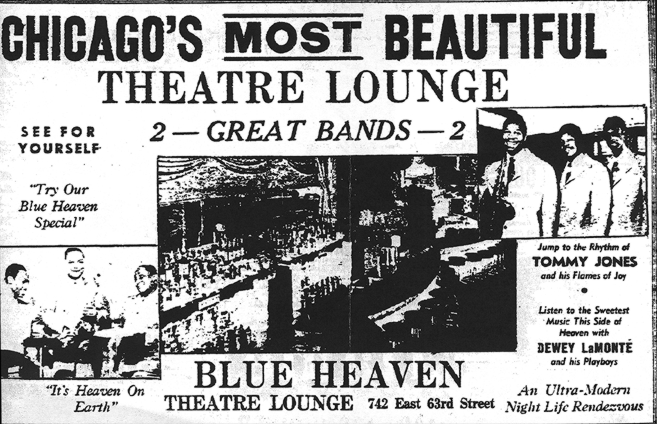
Revision note. We recently learned of a second Mad 1205 (same release number on both sides), which makes the third single by the Apocryphals (courtesy of Joel Mills, in an email of July 23, 2017). We have added information about the release dates for Mad 1006 and 1007, Cameo 146, and Apex LP 4924. We have added information about Tommy Jones' fourth LP Mama, which was released on M&M 2891, and (at last) on his second LP, A Different Sound, M&M LM-27. We have also added six sides from three 7-inch 45 rpm acetates now in the possesion of Armin Büttner; two of the acetates are from a 1959 session that was apparently never released, and the third is from session Mad46 for the Song for Mary LP.
The Mad label came out of the rich "honkers and barwalkers" tradition in Chicago. Tenor saxophonists, in emulation of Illinois Jacquet's "Flying Home," would jump up on the bars and squall and blast on their horns. If any one tenor sax blower epitomized this tradition it would have to be Tommy "Madman" Jones, who for nearly three decades decades entertained Chicago nightclub audiences with wild exuberant performances on his instrument.
In the 1940s and 1950s, Jones was generally considered a jazz player, and his bebop heritage is frequently audible on his records. But he had a strong orientation toward the blues (he was sometimes billed as "Madman Jones and his Blue Saxophone"), and his style exhibited such hard blowing and energy that it could just as easily be considered rhythm and blues. Jones was credited for inventing a unique amplifier for the saxophone, which he later gave aspiring honkers and barwalkers lessons on. He made a few records in the 1940s and 1950s, but he built his reputation mainly as a nightclub performer.
Jones was born Thomas Douglas Jones Jr., on October 19, 1922, in Chicago. He started playing the saxophone when he was about twelve, but dropped the instrument, and although he attended DuSable High School, where the great Walter Dyett directed the band, he was not interested in music studies at the time. It was at the ripe old age of 22, according to Jones, that he was inspired by Charlie Parker to take up the tenor sax again.
By 1945, he was making an impression on the city's club scene, calling his trio Tommy Jones and His Flames of Joy. The Chicago Defender shows this group playing El Casino Cafe (823 East 39th) in early December of 1945 (in fact, his indefinite contract with the club was accepted and filed by Musicians Union Local 208 on November 1).

By the end of the year had moved down to flourishing 63rd Street, opening at the Blue Heaven Theater Lounge on December 21 (the club was lcoated at 742 East 63rd, and his 3 week contract was filed on January 3, 1946). On June 6, 1946, Musicians Union Local 208 accepted and filed his contract for 1 week at the Band Box (a club on Randolph Street in the Loop) and an indefinite contract with Frank's Caravan. By the end of 1946 Jones was starring at the prestigious Hurricane Show Lounge (347 East 55th). In November 1947 he led a trio on the off night at the Macomba Lounge (39th and Drexel); we know about this engagement, at a club whose owner didn't want to pay for advertising, because he was called in front of the Board of Musicians Union Local 208 for inviting Thomas Davie to jam with his band (see minutes for November 20, 1947, p. 3).
Jones' exuberant persona and wild playing soon earned him a following. Said he, "I used to walk the bars, blowing my sax. I sang a lot, told jokes, that kind of stuff, and they just started calling me 'Madman.'" In March 1948 the famed Grand Terrace ballroom (317 East 35th) first advertised him with the moniker. He also made his first records as a leader. At least the Club Royal (648 East 47th) advertised "Tommy Jones and his Re Bop Recording Combo." Unfortunately, we don't know which label he cut these recordings for, and no evidence of them has turned up.
During the 1950s, Jones continued to be popular attraction in the South Side clubs, performing at Joe's Rendezvous Lounge (2757 West Madison), Club Evergreen (1322 Clybourn), the fabled Bee Hive Lounge (1503 East 55th), the Cabana Gardens (2711 Wentworth), and New Rocket Show Lounge (5114 South Prairie).
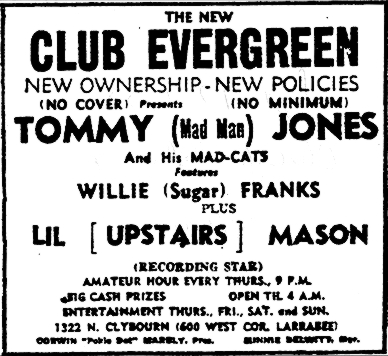
In the July 19, 1953, issue of the Chicago Defender, the column "What the Cats Do While the Squares Sleep" declared: "Tommy 'Madman' Jones and his orchestra are still rocking the Club Evergreen with his sax and band. Featured with Jones is that sensational blues singer, Lil Mason." The same lineup was still being advertised at Club Evergreen on September 17, as can be seen in the Defender advertisement above.
Although Tommy Jones did not usually take gigs beyond Illinois and its neighboring states, he spent part of 1955 on a package tour with Roy Brown and the Hollywood Revue. Also featured on the bill were Linda Hayes and Johnny "Guitar" Watson, backed by "Tommy 'Madman' Jones" and his six piece group." After appearances in Texas, Colorado, and Arizona, they were slated to appear at the Five-Four Ballroom in Los Angeles, February 18-20, 1955 ("Star-Studded Show Planned for Week End," Los Angeles Sentinel, February 17, 1955, p. A11).
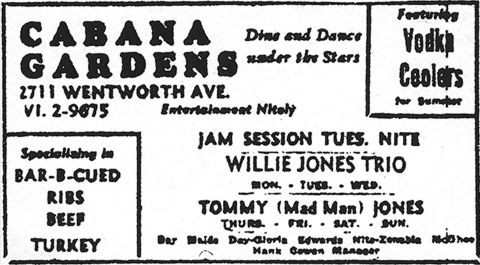
In its August 8, 1955 issue, the Defender carried the brief item: "...With Willie Jones Trio first half of the week and Tommy 'Madman' Jones for weekends, the Cabana Gardens, 2711 Wentworth, jumps every night." An ad from July 30 shows that Tommy Jones was working Thursdays through Sundays at the club. A few years later the two Joneses, who were not related, would be working together.
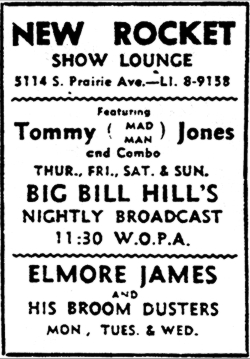
At the New Rocket, as a Defender ad from February 11, 1956 indicates, Jones and his combo split the week with bluesman Elmore James. The New Rocket was following the formula previously established by Ada's Chicken Shack, where each week Lucius Washington's band had alternated with blues headliners.
According to a Defender advertisement from March 9, 1957, Jones and his Rhythm Kings were holding forth at Stelzer's Restaurant (35th and South Park).
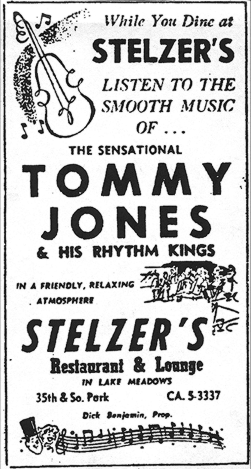
Although a perennial club favorite, Jones got limited recording opportunities. He first showed up on record as a sideman with Dick Davis for Miracle in June 1946. Jones got a solo on "Tenor-Mental Moods," a three-way tenor battle with Davis and Eddie Chamblee. (Although some sources have put Jones on the second Dick Davis session of January 1947, Davis is the sole horn on that outing.)
In 1951, Jones joined Jimmy "BB" Robinson (piano), Israel Crosby (bass), and Jump Jackson (drums) backing four blues sides by Jack Cooley. Cooley appears to have recorded these himself (he had previously operated his own C&G label), then dealt them to Nashboro; both singles are extremely rare today.
In March 1952, Tommy Jones picked up a sideman appearance with bluesman Arbee Stidham for Checker. (If you want to hear him in maximum bar-walking mode, the Stidham session is the one.)
And on what proved to be the very last session for States, in July 1957, he played baritone sax on another Arbee Stidham date; Sugarman Penigar got the tenor spot. That's all: four sideman appearances in 11 years. No one was making Jones offers to record as a leader. So he decided to start his own company, mainly to get himself on wax.
Although he held a recording session that was meant to lead to a release around October 1956, it was not until November 1957 that Jones was ready to launch the Mad imprint. Around 1960 he added M&M. Jones' address for the operation was 1207 East 53rd Street. In 1959, the Mad label (and subsequently M&M) became a part of a combine that included the Apex label run by Bill "Bunky" Sheppard and the Dempsey label operated by Norman Dempsey. The Apex-Mad-Dempsey operation's headquarters were at 951 East 47th Street. When this combine collapsed in 1962, Jones continued his Mad and M&M imprints independently until 1991.
Most of the original Mad acts were somewhat dated by the late 1950s. This reflected Jones' own background. His early roster included Tony Smith and the Aristocrats, the Four Shades of Rhythm, Lefty Bates and His Band, and blues singers Honey Brown and Piney Brown. All had been active in the clubs or on record in the 1940s.
As Jones persevered with his labels, he added acts that reflected newer trends in popular music, such as two doowop groups, the Equallos and Little Prince and the Freeloaders. In the blues vein, he released four sides by Willie Mabon, two sides by Little Eddie, and two sides by Billy "the Kid" Emerson. Most importantly, Jones was responsible for the very first releases by Oscar Brown Jr., Red Holloway, E. Parker McDougal, and Clarence Wheeler and the Enforcers. That is no small achievement.
Jones did a handful of sides at Universal Recording, but he did not continue there because he found it too costly. Most of the Mad material was recorded at a "little place on Michigan Avenue because it was very cheap." His was an economical operation, as he explained: "I took all the money I made and put it into the record business. I was doing it so cheaply, it wasn't even funny. I'd make a thousand records and it really did not cost too much, but it was the most I could do."
The Mad label was launched in November of 1957 with the 1200 series. However, the matrix numbers for Mad 1201, which was mastered and pressed by RCA Victor, are in the G series from 1956, so the launch was delayed, by at least a year. Since October 1956, if not earlier, Jones must have had boxes of singles pressed up and sitting in inventory. There is not much to go on with regard to matrix numbers over the subsequent history of the company, so frequently we will have to make each single a separate discographical entry. What became evident very quickly when we began to research these labels is the extraordinary number of recordings not documented in Tom Lord's 26-volume series The Jazz Discography (1992-2001). For the sessions that he did cover, however, Lord supplied us with related recording information.
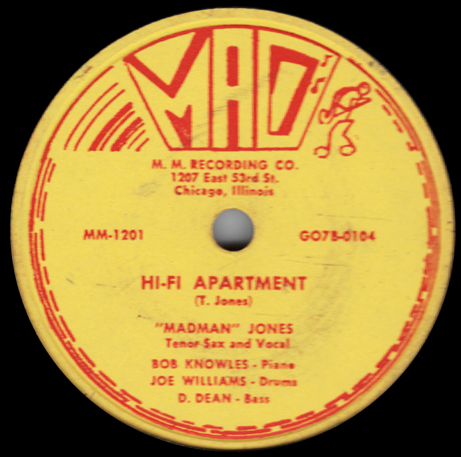
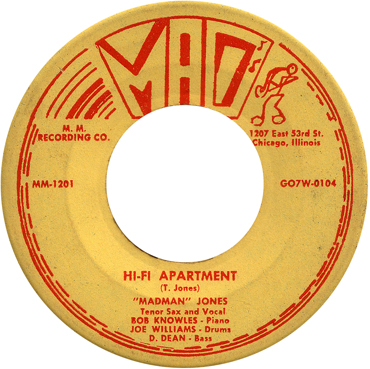
Tommy Jones (ts, voc); Bob Knowles (p); Dolphus Dean (b); Joe Williams (d).
Universal Recording, Chicago, 1956
| GO7B-0104 (78) GO7W-0104 (45) |
Hi-Fi Apartment (Jones) [TJ, ens voc] | Mad 1201, Mad MR-1005 [CD] | |
| GO7W-0105 (78) GO7W-0105 (45) |
Rooster Rock [TJ, ens voc] | Mad 1201, JD 002, Mad MR-1005 [CD] | |
| 1204-1 | I Surrender Dear* | Mad 1204 | |
| 1204-2 | Love One Another* [TJ voc] | Mad 1205 |
The 1201 release was announced in the trade papers in November 1957, the 1204/1205 release in December 1957. A listen to 1204/1205, courtesy of Dr. Robert Stallworth, shows that they came from the same session. On Mad 1201 and 1204/1205, the good clear sonics indicate a Universal recording. Mad 1201 is the only release on the label to appear on 78 as well as 45 rpm.
Many years later, "Rooster Rock" became a part of a German LP collection of frantic early rock 'n' roll called Rock 'n' Roll Murder, Vol. 2, issued on the JD label. Mad MR-1005, The Best of Mad Records, is a bootleg CD issued in 2003 and sold by Dead Dog Records.
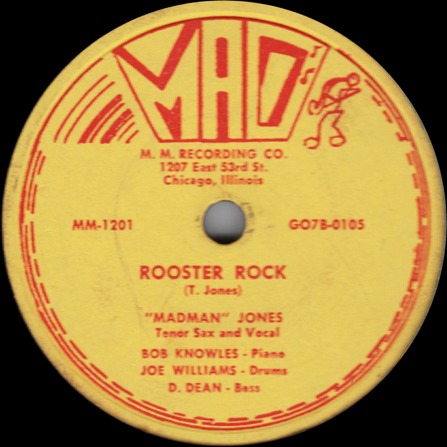
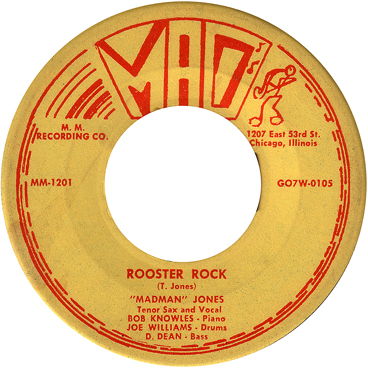
"Hi-Fi Apartment" is a blues with the same basic approach as Bunky Redding's 1947 record of "Take It Upstairs" (see our Red Saunders page for details). But since Madman Jones is singing in 1957, he adds embellishments to the amazing crib, like a life-size color TV screen, and a robot servant "at my beck and call." The number also features a tenor sax solo. "Hi-Fi Apartment" was remade around 20 years later, as "High Fi" from session Mad51.
The personnel for Mad 1201 is listed on the labels.
We thought we heard the distinctive electric bass playing of Wilburn Green (an alumnus of Sun Ra's 1956 Arkestra) on "Hi Fi Apartment." Green would make a couple of further appearances on sessions for Mad. However, the labels on the original Mad 1201 indicate that Dolphus Dean was on bass, and he normally played the upright model. Beginning in 1957, Dean and Knowles would spend several years in the Amazzing Trio, with George Green as the drummer and vocalist. However, in 1956, Green was working with no less than Ramsey Lewis and Eldee Young.
Mad 1204 gives us Tommy Jones turning in what may his greatest performance, on "I Surrender Dear." (And Tommy Jones, as we will see, was outstanding on ballads.) It will hold up against any of the great jazz ballad performances, including Coleman Hawkins' rendition of the same tune; what a shame it's only circulated on an obscure 45 with a maximum press run of 1000. 1205, on the other hand, is Jones' own lounge ballad on the subject of world peace; it is strictly a vocal vehicle. Bob Knowles' playing resembles his later work on the two George Green LPs (see below).

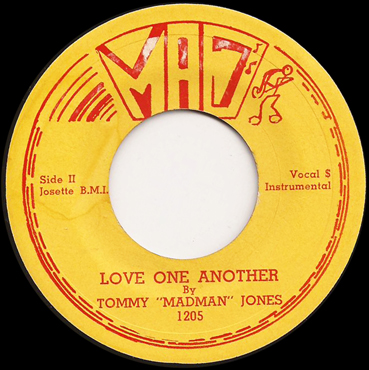
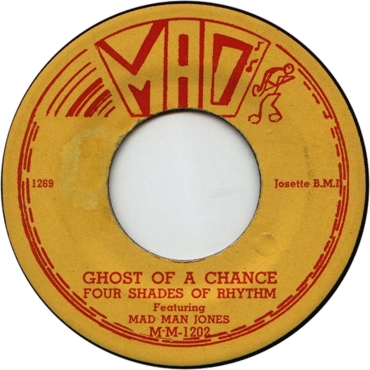
Oscar Lindsay (voc); Tommy Jones (ts); poss. Ernie Harper (p); poss. Adam Lambert (eg); poss. Booker Collins (b).
Chicago, 1957
| 1268-B | Come Here (Jones) | Mad M-M-1202, Mad MR-1005 [CD] | |
| 1269-B | Ghost of a Chance* | Mad M-M-1202 |
This release was reviewed in Cash Box on November 23, 1957. "Ghost of a Chance" is an instrumental; Oscar Lindsay alternates lead vocals with other members of the band on "Come Here." (Tommy Jones liked "Ghost of a Chance" a lot, recording it three times.) Mad MR-1005, The Best of Mad Records, is a bootleg CD issued in 2003 and sold by Dead Dog Records.
The Four Shades of Rhythm were formed in Cleveland in 1945. The original members were Oscar Lindsay (drums and vocals), Willie Lewis (guitar), Sim London (piano), and June Cobb (bass). Drastically changed in personnel by the time the group established themselves in Chicago, Lindsay with Oscar Pennington (guitar), Eddie McAfee (piano), and Eddie Myers (bass) recorded in December 1947 for Vitacoustic (a popular ballad, "One Hundred Years from Today"). In the summer of 1948 they did a freelance session for Al Benson that was later released on Old Swing-Master. With a different lineup, the Four Shades made a bunch of sides in Milwaukee, Wisconsin, in 1951. Presumably intended as demos, they were never released. A reorganized group—Lindsay, Ernie Harper (piano), Adam Lambert (guitar), and Booker Collins (bass)—then made a recording for Chance in 1952. The Mad release was the group's next recording effort. By this time, Lindsay may have been the only member left from the Chance session—the histories we have are unclear.
Tommy Jones can be heard on both sides of the 45. On "Come Here," the guitarist produces some percussion by tapping or slapping the side of his instrument—a technique popularized by Tal Farlow of the Red Norvo Trio and Ray Crawford in Ahmad Jamal's 1951-1955 trio.
The final Four Shades of Rhythm recording was a remake of "One Hundred Years from Today," which appeared on Apex in 1960. The basic group is no longer in evidence, on a record drenched in violins and vocal choruses. Lindsay organized a trio in the 1960s that was still performing in the early 1980s; he died in May 2000 or a little earlier.
We obtained the group's history from Peter Grendysa, "Blues and Jazz Collide in Chicago: Cats 'n' Jammers; Four Shades Of Rhythm," Record Collector's Monthly #8 (April 1983): 1, 10-11; and Marv Goldberg, "The 4 Shades Of Rhythm," Discoveries #120 (May 2000): 24.
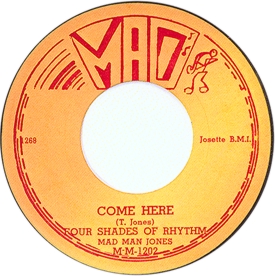
The Mad label seems to gone on hiatus between December 1957 and the late spring of 1958.
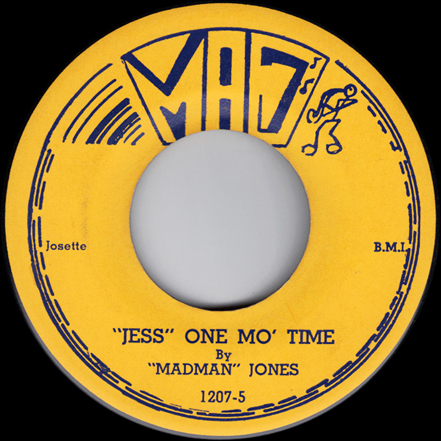
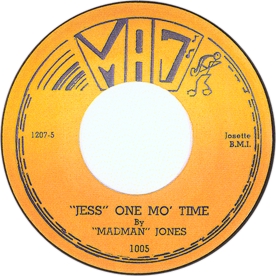
Tommy Jones (ts except -1; voc); L. Dean (p); B. Hargis (b); Charles Walton (d); F. Zarate (timbales); E. Gutierrez (cga); unidentified females (bg voc -2).
Chicago, early 1958
| 1207-5 | "Jess" One Mo' Time (Jones) [TJ voc] -1 | Mad 1207, Mad 1005, Cameo 146, Mad MR-1005 [CD] | |
| 1207-6 | Oh Henry (Fuller-Henry) | Mad 1207, Mad 1005, Cameo 146, Mad MR-1005 [CD] | |
| 1207-13 (1011) | Snake Charmer (Dean-Jones) [TJ voc] -1, 2 | Mad 1208, Mad 1008, Mad A1 [CD] | |
| 1207-14 (1012) | Josette (Jones) | Mad 1208, Mad 1008 |
Tommy Jones must have transferred his operation to the cheap place on Michigan Avenue; balances are often weird and the piano provided to L. Dean isn't the best. Mad 1207 was announced to the trade press in May of 1958. In June of 1958 Jones relaunched his operation with a 1000 series. The issue on Mad 1005 was billed as "Tommy 'Madman' Jones & His Band." Mad 1008, credited to "Mad Man Jones and His Band" was released in August 1958.
The Cameo issue (also on 45) quickly followed Mad 1005. (See http://www.angelfire.com/me2/vinylphilly/Cameo45complete.html for a Cameo/Parkway 45 listing.) Billboard announced the deal between Tommy James and Bernie Lowe of Cameo for the master in its July 28 issue ("On the Beat," p. 46). Cameo 146 was already out, having gotten a review in Cash Box a couple of days earlier (July 26, 1958, p. 14); "Jess One Mo'" was described as a rock and roll side. Cameo/Parkway, a Philadelphia-based company that was established in 1957 and produced a fair number of rock and roll hits, did not continue its relationship with Tommy Jones.
On Mad 1208/1008, the 1207 numbers are on the label; the 1011/12 numbers are in the vinyl.
Mad A1, a CD titled Tommy "Madman" Jones & His Friends, was Tommy Jones' last production. It was released in Amsterdam in 1991 while Jones was resident there. Jones' own notes to the CD allow us to fill out the personnel for this session. "Snake Charmer" is an eccentric performance featuring Jones' spooky chanting ("Slithering! Sliding!") and much Latin percussion; the female vocalists are barely heard on the fade. Mad MR-1005, The Best of Mad Records, is a bootleg CD issued in 2003 and sold by Dead Dog Records.
"Oh Henry" is the Gil Fuller - Ernie Henry composition originally recorded by James Moody's Modernists for Blue Note in 1948.






Jimmie Gilmore (p -1; org -2); Bill Casimir (ts); Lynn Sherrill (eg); Tony Smith (d).
Chicago, 1958
| 1207-7-45 | Rippling Waters (Gilmore) -1 | Mad 1006 | |
| 1207-8-45 | Big Nellie's (Smith) [ens voc] -2 | Mad 1006, Mad MR-1005 [CD] |
Mad 1006 was advertised in Cash Box on July 5, 1958 (p. 121) and mentioned in Billboard's "On the Beat" column on July 28 (p. 45).
There are two known versions of the labels for Mad 1006. On one version, the names of the band members are listed on both sides. On the other, the band is merely identified as "Tony Smith & His Aristocrats."
On the first version, Bill Casimir's name is misspelled on the label of the "Big Nellie's" side, and Gilmore is credited with piano on both sides even though he plays organ on "Big Nellie's."
Mad MR-1005, The Best of Mad Records, is a bootleg CD issued in 2003 and sold by Dead Dog Records.
"Rippling Waters" (designated as Side 1 on the 45) is a piano feature for Gilmore; it borders on exotica and would have been right at home on a Sun Ra LP from the same era. "Big Nellie's" sounds like a closing instrumental, with members of the band joining ensemble-style to shout out "going down to Big Nellie's." The band played this number throughout their career to energize their audiences. A second tenor sax can be heard in the background on "Nellie's"; we assume it is also Bill Casimir, overdubbed.

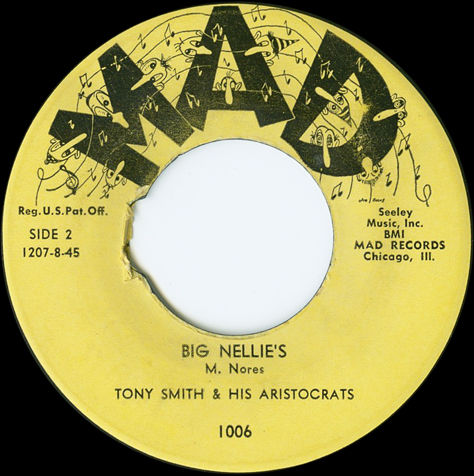
Tony Smith and the Aristocrats, who organized in 1947, represented the proto-rock 'n' roll element of postwar African American club music. The group had the typical instrumentation of a 1940s jazz combo—saxophone, piano, guitar, and drums—but as the leader, Tony Smith, related, "All our music we made had a more driving beat than other groups, because I was heavy on the drums. I really did keep my foot heavy on the drums." In their heyday in the late 1940s, Tony Smith and the Aristocrats developed a strong club presence, but failed to get on record. It was not until 1956 that the group first hit the studios, for Mercury.
Tony Smith was born in St. Louis (on July 28, 1926), and formed his first band while still attending Sumner High. After the war, he moved up to Chicago and formed the Aristocrats in 1947. Chicago served as a magnet for black entertainment, as all the other members of this group came from the South—Bill Casimir (tenor saxophone), from New Orleans; Curley Jackson (piano), from Mississippi; and Lynn Sherrill (guitar), from Dallas. Sherrill (born February 28, 1918) was somewhat older than the other members. Smith recruited him by going to the Musicians Union and asking for a guitarist.
The group's first club date of note was at Ada's Chicken Shack & Tavern (5114 Prairie), on the South Side. Nearly at the same time, however, a Lefty Bates group, the Aristo-Kats, were playing regularly in town and promoting their latest RCA Victor recording, "Jack, You're Dead." Discographers and historians have often confused the two groups.
By the early 1950s, Tony Smith and the Aristocrats of Rhythm became a fixture on the city's North Side, playing before predominantly white customers. For nine years, the group performed at The Whip (4334 North Pulaski Road). Tony Smith briefly got into the nightclub business, joining with bandleader Harold Youngblood to open the Cotton Club (6249 South Cottage Grove) in early 1954. One of the acts that played the club was Jimmie "Gene" Gilmore, who was promoted as a romantic balladeer. Gilmore had been around, having performed as a solo pianist/singer for some years, after beginning his career in the early 1940s with two Willie Dixon groups, the Five Breezes and the Four Jumps of Jive.
In 1956, a Smith group finally got on record, cutting two jump tunes for Mercury—"Wiggle Waggle Walk" b/w "Wacker Drive." By this time, Jimmy Gilmore had taken over the piano stool from Curley Jackson, and become the primary vocalist.
After his Mad session, Tony Smith continued to work regularly on the North Side and in the Chicago suburbs, putting out three low-circulation LPs to promote his live appearances. (He also recorded for a label called Crystal, according the liners to his first LP. We have yet to trace this release.)
The first LP was done, most likely in 1969, for a label called Sanns, with a supercheap generic front cover design. Sanns 004 was titled Tony Smith Live at Fred Allegretti's Four Horsemen Lounge. We estimated the date from the inclusion of "Green Apples," a pop hit that year for O. C. Smith. Lynn Sherill and Bill Casimir were still in the group; blues musician Lacy Gibson, who had joined the Aristocrats a year earlier, was playing bass and contributing tunes, including his "Unmask the Batman" and "Easy Woman" (better known from his single on Repeto, a label run by Sun Ra's manager, Alton Abraham). A remake of "Big Nellie's" was the final track on Side B.
Smith then started a boutique label called De Tone. Its first release, DT-2900, was titled Hi-Yo Silver after a number that the band had been peforming for nearly two decades; the art budget had grown to allow a cover photo of the leader, in band uniform and cowboy hat, atop a white horse. It also included a celebratory poem on the front cover, crediting "Dee" as the author. From the inclusion of "Games People Play" by Joe South, which was a big hit in 1969, we figure the album was made around 1970; Smith used it as part of a medley on which he showed his command of the steel drums. Lynn Sherrill and Bill Casimir were still in the group, but "Doc" Jones had taken over from Lacy Gibson on the electric bass; he also divided the vocal chores with Tony Smith.
Smith's second (and so far as we know, last) LP on De Tone was DT-2901, Maharajah Man, recorded and released in 1974, with the same lineup as the first. The covers showed all four band members wearning turbans.
One of the most durable performers on the Chicago scene, Tony Smith was still leading a band (with Diane Ellis, tenor sax; Alonzo Smith, synthesizer and vocals; and Jim Pryor, bass and vocals) in 2013. According to his business card, the quartet played jazz, blues, rock and roll, and Caribbean music.
Our profile is based on: Bob Pruter's telephone interviews with Tony Smith and Lynn Sherrill, 4 November 1998, Chicago; and with Bill Dahl, 6 May 2001; newspaper items and ads from the Chicago Defender, 1947; newspaper ads from the Chicago American, 1953-54; and Chicago Sun-Times, 1968. Armin Büttner unearthed Tony Smith's Sanns LP, and Dan Ferone was our source on the De Tone LPs.
Louis Carpenter (org -1 ; p -2); Johnny Thompson (ts); George Freeman (eg); Steve Trimble (b); Buddy Smith (d); Tommy Jones ("yeahs" on *)
Chicago, 1958
| 1207-9 | Yeah! (Carpenter-Thompson)* -1 | Mad 1007, M&M 23, Mad MR-1005 [CD] | |
| 1207-10 | Cha Cha Boogie (Carpenter-Thompson) -2 | Mad 1007, M&M 23, Mad MR-1005 [CD] |
Mad 1007 was advertised in July 1958; Billboard said on July 28 ("On the Beat," p. 45) that its release was imminent. Mad MR-1005, The Best of Mad Records, is a bootleg CD issued in 2003 and sold by Dead Dog Records.
The group featured veteran jazz players from the Chicago scene. The leader, Louis Carpenter, was a Willie Jones acolyte; he had been a regular in Lucius Washington's combo (1949-1952) and participated in several recording dates for Chance in 1953 under Red Holloway's leadership. Often billed as Lewis Carpenter in club ads, he also briefly led an organ trio when these were all the rage in the Black community and Chicago was painfully short on Hammond B-3 expertise; the trio played a week or two at Budland in June 1956. By the time of his Mad session, Carpenter had long since returned to the piano. His brief solo on "Cha Cha Boogie" uses Willie Jones' characteristic locked-hands procedure.
The Louis Carpenter session is one of the few to include tenor saxophonist Johnny Thompson (a veteran of the 1948 King Kolax combo, and of a very early phase of the Sun Ra Arkestra in the fall of 1955). In fact, this appears to be Thompson's last recording. The personnel was listed on the label; thanks to Dan Kochakian for alerting us to the presence of Steve Trimble on bass (we had left him off our listing).
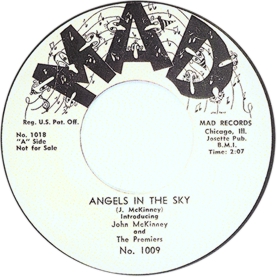
John McKinney (voc); other vocal group members unidentified; unidentified (p); unidentified (eg); unidentified (eg); unidentified (b); unidentified (d).
Chicago, 1958
| 45-1018 | Angels in the Sky (McKinney) | Mad 1009 A, Mad MR-1005 [CD] | |
| 45-1019 | Gee (How I Love You) (McKinney) | Mad 1009 B, Mad MR-1005 [CD] |
Jones now began to explore doowop. Mad 1009 was advertised in Cash Box on October 4, 1958 (p. 40). "Angels" is a sappy doowop ballad; "Gee" is a dreadful number with a Latin rhythm. Both appear to have been recorded in someone's living room. Thanks to Dr. Robert Stallworth for providing scans of a 45 in his collection. Mad MR-1005, The Best of Mad Records, is a bootleg CD issued in 2003 and sold by Dead Dog Records.
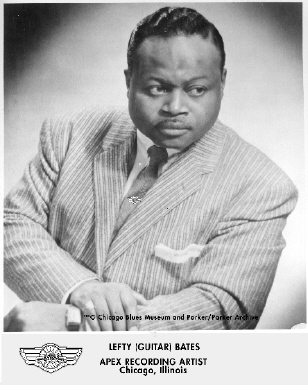
Eileen (-1, 2) and Stan (-1) (voc); Lefty Bates (eg); other musicians unidentified.
Chicago, 1958
| 58-45-728-1 | Bang Bang Shoot 'em Ups (McBride-Sheppard) -1 | Mad 1010 | |
| 58-45-728-2 | Has Anybody Seen My Dog (McBride-Sheppard)* -2 | Mad 1010 |
Who Eileen and Stan were has been lost in the mists of time. But the composer credits indicate that a merger (with Dempsey and Sheppard) was at the very least being contemplated.

Lefty Bates (eg, ldr) with Cliff Davis (ts); prob. Mac Easton (bars); prob. Floyd Morris (p); Quinn Wilson (b); prob. Alrook "Al" Duncan (d).
Chicago, 1958
| 58-45-98-5 | Am I Blue (Akst-Clark)* | Mad 1011, MR-1005 [CD] | |
| 58-45-98-4 | Back Ground (Davis-Sheppard) | Mad 1011, MR-1005 [CD] |
Mad 1011 was a 45-rpm single released in 1958 or 1959. Mad MR-1005, The Best of Mad Records, is a bootleg CD released in 2003 and sold by Dead Dog Records.
Other than Cliff Davis and Lefty Bates, we are speculating on the personnel.
"Am I Blue" is a rocked-up version of the standard, with a rather corny tenor sax lead by Cliff Davis. He redeems himself to some degree during his full chorus solo. "Back Ground" features a hot, rocking guitar solo by the leader.
William "Lefty" Bates was born in Leighton, Alabama, March 9, 1920. He was raised in Saint Louis, where he went to Vashon High School. While still in secondary school Bates formed a vocal/string band, a kind of ensemble that was extremely popular in the black community during the 1930s and the 1940s. The group was called the Hi-De-Ho Boys, and consisted of Tommy Powell (dance / vocals), James Crosby (bass / vocals), Lefty Bates (guitar / vocals), Bill Williams (guitar / vocals), Walter Jones (guitar / vocals), and Cleo Roberts (guitar / vocals). The Hi-De-Ho Boys moved to Chicago in 1936, recorded once for Decca, and became a semi-regular act at the Club DeLisa from 1937 to 1950.
Bates served in World War II, and when he got out formed his own combo. He then joined the Aristo-Kats, who successfully recorded two sessions and garnered four releases for RCA Victor. The members besides Bates were Orlando Randolph (trumpet/vocals), Quinn Wilson (bass), and Julius Wright (piano). When the Kats broke up in 1948, Bates rejoined the Hi-De-Ho Boys, who made a valedictory session for J. Mayo Williams' Harlem label in 1950.
In 1952 Bates formed a trio with Quinn Wilson (bass) and Horace Palm (piano). Through much of the decade he played regularly with this group (sometimes increased to a quartet with a horn player) at such clubs as Duke Slater's Vincennes Lounge (601 East 36th), the Shalimar Club (5659 Wentworth), Banks' Trocadero Lounge (4719 Indiana), and Spruce's Duck Inn Lounge (5550 South State). When this session was recorded Palm was probably no longer with the trio, but Wilson certainly was.
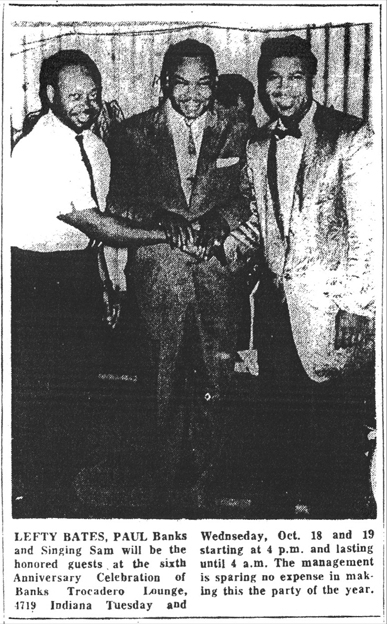
Bates recorded minimally under his own name, producing one release on Boxer (1955), one very rare single on United (1957), and two on Apex (1959), as well as this session on Mad (1958). None of the sides achieved any kind of traction, not that this mattered. Lefty Bates earned his money in club gigs and as the guitar player most in demand for recording sessions; he laid down countless sides for Vee-Jay, but also did work for much smaller operations like Club 51 and Mad. Lefty Bates' last musical affiliation was with the Ink Spots during the 1970s. In 2001, he entered a nursing home because of the onset of Alzheimer's disease. Lefty Bates died on April 7, 2007.

Our session details are from Mike Leadbitter and Neil Slaven (LS), Blues Records 1943 to 1970, A Selective Discography (London: Record Information Services, 1987). The biographical details come from Peter Grendysa, "Making Tracks Chicago Style: The Four Clefs, Five Breezes, Four Bluejackets, and the Aristo-Kats," Goldmine 4 January 1985; Robert Pruter's interview with Lefty Bates, 4 November 1998; and Chicago Defender clips from 1936 through 1960.
Musicians unidentified.
Chicago, prob. 1958
| 45-1035 | Candy Store (Petruzzi) | Mad 1012 | |
| 45-1036 | Those Bells (Petruzzi) | Mad 1012 |
Another, er, experiment. Bob Sladek reports that Mad 1012 was made by a big band trying to do rock 'n roll. In his opinion the lyrics are so elementary, it appears the writers were trying to sound dumb in vain pursuit of teen appeal. Some record companies were still trying to fake rock and roll in 1958. For instance, "Soda Pop Rock" (Stepheny SF1821, recorded in February of that year) would prove to be the swan song for blues singer Grant Jones. He was weighed down by two dopey tunes, with phony rock and roll provided by a combo led by Swing tenor saxophonist Mike Simpson. Art Langille made one other recorded appearance that we know of, in the saxophone section of a studio big band led by Fredie Wayne. The Wayne band, playing jazz arrangements by Jerry Nowak, recorded an LP for Stepheny in July 1958. It was released in 1959 as MF 4008 (mono) and LR 8006 (stereo).
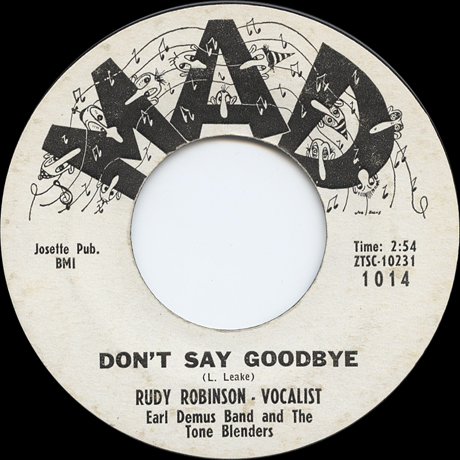
Rudy Robinson (voc); with Earl Demus (b, ldr); prob. Hobart Dotson (tp, arr); unidentified (ts); unidentified (bars); Lafayette Leake (p); unidentified (d); The Tone Blenders: unidentified vocal group (3 females).
Chicago, prob. July 1958
| ZTSC-10230 | When You're Hurtin [sic] (Leake) | Mad 1014, Mad MR-1005 [CD] | |
| ZTSC-10231 | Don't Say Goodbye (Leake) | Mad 1014, Mad MR-1005 [CD] |
The ZTSC numbers indicate that Mad was now getting its records pressed by Columbia (as many small indies were doing at the time). Mad MR-1005, The Best of Mad Records, is a bootleg CD issued in 2003 and sold by Dead Dog Records.

Rudy Robinson croons two sentimental pop tunes in a smooth baritone; further sweetening is quite unnecessarily supplied by the female backup singers. Pulling in the opposite direction are serious jazz arrangements performed by Earl Demus' ensemble. The arranger is not credited but the lead trumpet and the scoring appear to be the work of Hobart Dotson, who was very active in Chicago at the time. Dotson, who had done some striking arranging for a date on Verro in 1956, was starting to work with Sun Ra when this session was made. Meanwhile Demus had played in Ra's band back in 1954 and some of his later recordings (e.g., for the Marvello label) would travel in a Ra-ological direction. The lead trumpet on "Goodbye," thinned out by poor miking, is extremely Dotsonian. On "Hurtin" the trumpet player provides a burnished accompaniment, emphasizing the middle and lower ranges of his horn, but poor mike placement (or amateurish overdubs) make the horns appear to be hiding behind the bandstand. There is also a brief piano solo partly buried under a female chorus. Since Lafayette Leake composed both tunes and he and Earl Demus would later record together for Marvello (see below), his presence is a safe bet here.
Rudy Robinson was born on May 16, 1932, in Akron, Ohio, the son of a minister. He began singing as a youngster in his father's church choir, and at Akron East High majored in music and drama. He graduated from the MacDonald Conservatory of Music, after studying voice for five years. Robinson came to Chicago in 1957 to be where the music business was located. Besides this Mad 45, Robinson released two other recordings: a pair on his own Rujo label (in 1959) with a Lafayette Leake combo, and a pair on C. J. (1966) with another Earl Demus band. Apparently Rudy Robinson died in Chicago in May 1991, but we need to confirm that this was the same person. Our basic biographical information comes from Robert Roy, "Record Producers Say Rudy Robinson May Be 'Singer of the Season'," Chicago Defender, 29 October 1959.
Robinson's Mad release has been dated 1959 but according to a key in the 2nd edition of The R&B Indies by Bob McGrath, Columbia's ZTSC series reached 10503 in January 1959. From the data that McGrath presents, we estimate that 10230 was pressed in early August 1958.
According to his Local 208 file, Earl Demus was born on October 20, 1920; the Earl Demus who graduated from Wendell Phillips in June 1936 was probably the same person. During at least 15 years on the Chicago scene Demus worked with an early Sun Ra group (December 1954). He also appeared on a James Scales session in the mid-1960s for the Marvello label (for which King Kolax did A&R work). Lafayette Leake also played on Scales' Marvello session.
Tommy Jones (ts); Floyd Morris (p, org); William "Lefty" Bates (eg); Quinn Wilson (b); Alrook "Al" Duncan (d).
Chicago, 1959
| Just Friends | Apex 4924 | ||
| Autumn Serenade | Apex 4924 | ||
| A Gal in Calico | Apex 4924 | ||
| Laura | Apex 4924 | ||
| Apex Blues | Apex 4924 | ||
| Josette | Apex 4924 | ||
| My Buddy | Apex 4924 | ||
| T.J.'s Rock | Apex 4924 | ||
| I Don't Stand a Ghost of a Chance with You | Apex 4924 | ||
| Charleston | Apex 4924 |
Tommy Jones now branched out into LPs for the first time. Apex 4924 was titled Just Friends, and credited to Tommy Jones with the Apex All Stars. The album would be called smooth jazz today: mellow saxophone, smooth organ, lyrical guitar, and soft bass work. It was released in 1959, when Mad Records became a part of the combine that included Apex and Dempsey. Dempsey Nelson told Cash Box (August 1, 1959, p. 24) that the LP was "released t'other day." Cash Box said it was titled "Blue Sax" but there isn't any other LP Nelson could have been referring to. We're including the session here because it was a Tommy Jones production.
Tommy Jones recorded two further versions of "Laura." A version with an organ combo was done for one of the Song for Mary sessions (Mad46), but not released; the final version, with a piano trio, was released on his valedictory CD (session Mad52). He would cut his third version of "Ghost of a Chance" in 1961 (session Mad21).
Tommy Jones (ts); unidentified (tp except -4); unidentified (bars except -4); unidentified (org -1, p -2); unidentified (eg); unidentified (eb); unidentified (d, perc); ens voc -3.
Universal Recording, Chicago, c. 1959
| V-621-59 | Swampy -1 | unissued acetate A | |
| V-622-59 | Boot Foot -2, 3 | unissued acetate A | |
| Boot Foot -2, 3 | unissued acetate B | ||
| Spring Is Here -2, 4 | unissued acetate B |
In 1959, possibly in one of his collaboration with Dempsey and Sheppard, Tommy Jones recorded at least four tracks that were never issued. They showed up years later on 7-inch 45 rpm acetates, in variable states of preservation, which are now in the collection of Armin B&umml;ttner. The Universal acetate with numbers on each side features an ensemble of trumpet, baritone sax, keyboard playing organ and piano, guitar, bass, and drums/Latin percussion. "Swampy" is a soulful instrumental with a solo by the leader. "Boot Foot" includes a salsa trumpet solo and some rather florid piano work, as well as an ensemble "Ugh! Boot foot!" Both are airplay length, indicating that a single release was planned. A second acetate, unfortunately in deteriorating condition with less information on the labels, couples a different take of "Boot Foot" (sounding like the same ensemble, but more prominence accorded to the bass); on the label, this is misidentified as "Satin Doll," possibly indicating a session mate that is now lost. "Spring Is Here" is a feature for Jones with the rhythm section.
In 1959, Jones launched a new Mad 1295 series that reflected his three-way alliance with Apex and Dempsey. On this series the parent company was identified as "Apex Producing Corp."

James "Red" Holloway (ts; voc -1); McKinley Easton (bars); Pete Hatch (org); Wayne Bennett or Lefty Bates (eg); James "Hog" Lee (b); Leon Hooper (d; voc -2).
Chicago, December 1958 or January 1959
| 962 ZTSC-10497-1KB |
Simple Steps (Holloway) -1 | Mad 1297, Mad MR-1005 [CD] | |
| 961 ZTSC-10498-1KA |
Ala Carte (Holloway-Hooper) -2 | Mad 1297, Crypt 102 (LP), Strip CD00102, Mad MR-1005 [CD] |
Mad 1297 was a 45-rpm single issued in 1960. Crypt 102 (LP) and its CD counterpart Strip CD00102 are compilations of strip music entitled Las Vegas Grind, Vol. 1. (Interestingly Volume 4 of this series is said to contains the track "For the Birds" by Madman Jones. Is this another Mad/M&M item by "our" Madman Jones?) Mad MR-1005, The Best of Mad Records, is a bootleg CD issued in 2003 and sold by Dead Dog Records. On the boot, Red's last name has morphed into "Hollander."
Thanks to files provided by Sean Dwyer, we know that "Simple Steps" is a rocking dance number with vocals by Red. Red gets two tenor sax solos and the guitarist also solos. "Ala Carte" is raucous rock and roll featuring the gross-out menu celebrated by Screaming Jay Hawkins, among others. The singer who calls out such delicacies as "elephant lips, " "baboon eyeballs," and "spider giblets"—and concludes the side "Somebody get me a baking soda, quick"—isn't Red; our guess would be Leon Hooper. Red is the only soloist on it.
Besides drummer Leon Hooper, who gets composer credit for "Ala Carte," we hear the omnipresent Mac Easton on baritone sax. In a conversation with Armin Büttner on March 26, 2010, Red Holloway confirmed the presence of Easton and Hooper, and said that Pete Hatch played the organ and James "Hog" Lee was on bass. He wasn't sure whether Lefty Bates or Wayne Bennett was the guitarist.
Holloway once told Bob Porter that there was an entire LP worth of material recorded at this session. (It would be wonderful to locate the rest, but we have no idea whether any of it survives.)
Red Holloway was born James W. Holloway on May 31, 1927 in Helena, Arkansas. He was raised in Chicago, where his family moved when he was 5 years old, and attended DuSable High School. He began on piano, but took up saxophone in 1942. The following year he was a member of the first edition of Gene Wright's Dukes of Swing. He then entered the armed forces. Upon release, he briefly rejoined the Dukes (in 1946), and attended the Chicago Conservatory of Music while playing with the Jump Jackson band. During the 1950s Holloway led bands at Club Evergreen, the Crown Propeller Lounge, Stage Lounge, and Roberts Show Lounge, among others, and became one of the premier session musicians for the city's R&B industry. He recorded multiple sessions for such labels as Chess, Chance, United/States, Vee-Jay, even mom and pop operations like Club 51 and Theron.

Holloway was mainly on the road in the 1960s, playing in the Lloyd Price, Bill Doggett, and Jack McDuff bands. Beginning in 1967, he was based in Los Angeles; around 1987, he moved up the coast to Cambria, California. In the jazz world, Holloway is known for four LPs recorded in New York on the Prestige label from 1963 through 1965. He did other LPs for Jam in LA (c. 1982), for Steeplechase in Copenhagen (1984), and for Concord Jazz on the West Coast (1987 and 1989). Despite the intensive demand for his services in the studio, Holloway's Chicago years are notable for a dearth of recordings under his own name. He recorded a session for Mercury in 1956, but the Mad session was the first that saw release (well, at least these two tracks saw release).
Red Holloway was still playing in 2010, when he made a trip to Switzerland to appear with the Blue Flagships band and back to Chicago for an event to commemorate Eddie Johnson. After suffering a stroke and kidney failure, he died in Morro Bay, California, on February 25, 2012.
Discographical information from Tom Lord's Jazz Discography; biographical information from an invaluable two-part article: Bill Greensmith, "Red Holloway, Part 1," Blues Unlimited #117 (January/February 1976): 4-10; "Red Holloway, Part 2," Blues Unlimited #118 (March/April 1976): 9-14. See Crown Propeller's Blog for a memorial tribute. We also drew from the obituary by Howard Reich in the Chicago Tribune, February 26, 2012 (http://www.chicagotribune.com/entertainment/music/ct-nw-red-holloway-obit-0226-20120227,0,3005292.column).
We previously dated this session 1960, but the ZTSC numbers show that Columbia pressed this 45 in late December 1958 or January 1959.
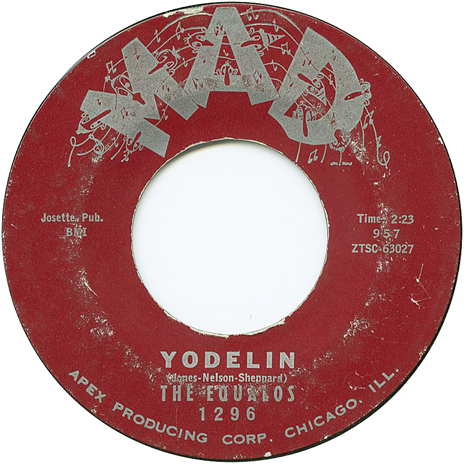
The Equalos: O.C. Logan: Willie Logan; Arthur Ford; Dave Hoskin (voc); Eddie King (p); unidentified (eg); unidentified (b); unidentified (d).
Chicago, January or February 1960
| 957, ZTSC-63027-1KB | Yodelin (Jones-Nelson-Sheppard) | Mad 1296, Mad MR-1005 [CD] | |
| 958, ZTSC-63028-1KA | Patty-Patty (Eddie King-O. C. Logan) | Mad 1296, LG 2027, Mad MR-1005 [CD] |
The Equalos were brothers O. C. Logan and Willie Logan, Arthur Ford, and Dave Hoskin. Their first release was on Mad in 1960. They recorded two disparate numbers, "Yodelin" and "Patty-Patty." "Yodelin" draws in equal proportion from the country yodeling tradition and corny saloon singing. The horrid unison motif for guitar and piano at the beginning is reminiscent of Eddie King's contemporary work for JOB (and King got co-composer credit for "Patty-Patty"). The guitarist redeems himself later with a brief solo. "Patty-Patty," on the other hand, is decent rock and roll with respectably rolling piano and a nice stinging solo from the guitarist. The Equalos' single on Mad 1296 failed to generate any response.
We previously dated this session to 1959, but according to the dating guide in the 2nd edition of McGrath's R&B Indies, the sides were pressed by Columbia in February or March 1960.
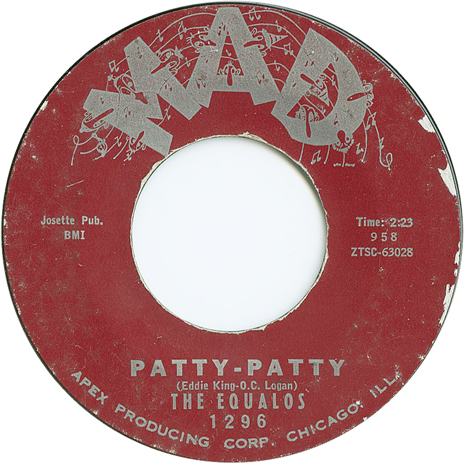
LG 2027 is a boot CD release of doowops, called A Million Dollars Worth of Doo-wop, Vol 11. It came out in 1995. Mad MR-1005, The Best of Mad Records, is a bootleg CD issued in 2003 and sold by Dead Dog Records.
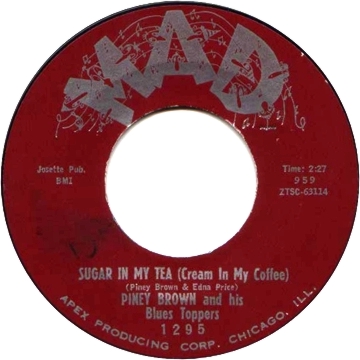
Piney Brown (voc); with prob. Tommy Jones (ts); prob. Mac Easton (bars); unidentified (org); William "Lefty" Bates (eg); unidentified (b); unidentified (d).
Chicago, February or March 1960
| 959 ZTSC-63114 |
Sugar in My Tea (Cream in My Coffee) (Brown-Price) | Mad 1295, Mad MR-1005 [CD] | |
| ZTSC-63115 | My Love | Mad 1295, Mad MR-1005 [CD] |
Mad 1295 is a 45-rpm single released in 1960 (not 1959, as discographies used to say). Mad MR-1005, The Best of Mad Records, is a bootleg CD issued in 2003 and sold by Dead Dog Records. Except for Lefty Bates, we have identified musicians by ear.
Piney Brown was born Columbus Perry on January 20, 1922, in Birmingham, Alabama. (Piney has kept his birth name under wraps; we got this information from Brian Baumgartner.) Piney Brown's first music experience was in a family gospel group. In 1940 he moved to Baltimore and there broke into show business. He made his first recordings for Miracle in October 1947. The parent label never issued any of his 4 sides, although one did see release in Great Britain in the early 1950s. His first releases were on Apollo in 1949, followed by Jubilee (1951), Sittin' in With (1952), Par (1952), and Atlas (1954)—all of them done in New York. In 1956, Brown teamed up with Duke recording act Billy Brooks to form the duo of Brooks and Brown. They appeared in several different shows at the Club DeLisa, where they were such a hit that Duke owner Don Robey recorded them in Chicago, using the King Kolax band and Lefty Bates on guitar.
The duo came to a parting of ways on tour in Kansas City, and Brown returned to Chicago in 1958. He first worked with Ralph Bass at Federal records, contributing the song "Just a Little Bit" to singer Tiny Topsy.
Early in 1960, Brown made this recording for Jones. (The ZTSC numbers applied by the Columbia pressing plant indicate that the records were pressed in March 1960.) Brian Baumgartner called the record "perhaps his most exciting effort to date." He noted that "Sugar in My Tea (Cream in My Coffee)" featured stinging guitar work by Bates and that Brown's "urgent vocals" sounded much like Otis Rush's work on Cobra. "My Love," Baumgartner thought, was "marred" by a cheap sounding organ solo, but that Brown's vocals offered "emotional blues." The number is a blatant imitation of Rush's "My Love Will Never Die," paraphrased as "My love / Will never move"; on it, Brown sounds like a hybrid of Otis Rush and Screamin' Jay Hawkins. By the time his Mad single was released, however, Brown had relocated to Kansas City.
Brown recorded subsequent releases for Heart, Tune, Deep Groove, Cimarron, Sound Stage 7, and New World, the last label coming out of his current hometown of Dayton, Ohio.
Our session details are from Leadbitter and Slaven; the biographical details are from the outstanding article by Brian Baumgartner, "Piney Brown: Now and Then," Juke Blues No. 48 (2000), pp. 28-37.
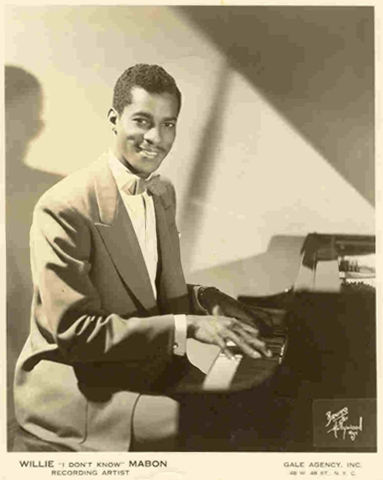

Willie Mabon (voc, Wurlitzer ep); Jay Peters (ts); prob. Mac Easton (bars); Harvey Hill (eg); Bill Anderson (b); Jimmy Bolden (d).
prob. Sheldon (Chess) Studio, Chicago, 1960
| U-537 | I Don't Know (Mabon) | Mad 1300, Mad MR-1005 [CD] | |
| AP-538 | I Gotta Go Now (Mabon) | Mad 1298, Mad MR-1005 [CD] | |
| U-539 | I Got to Have Her (Mabon) | Mad 1300, Mad MR-1005 [CD] | |
| AP-540 | Michell (Mabon) | Mad 1298, Mad MR-1005 [CD] |
Blues pianist and vocalist Mabon was still being advertised in the clubs as "Willie 'I Don't Know' Mabon" when he made these recordings; hence the remake of his 1952 Chess hit, "I Don't Know," plus the appearance of "I Gotta Go Now," which is cut to a similar pattern. In 1960 he was regularly performing on the West Side at the Macombo Lounge (3330 West Madison).
On his Mad session, Mabon plays an electric piano (recognizably a Wurlitzer) but the change of instrument doesn't seem to hamper him. His accompaniment includes a baritone sax uncredited in the sources available to us. As usual, the best bet for that role is Mac Easton.
Willie Mabon was born on October 24, 1925, in Hollywood, Tennessee (on "I Gotta Go Now" he threatens to head back there). He moved to Chicago in 1942. Although most of his work in the clubs was a soloist, he first got on record in 1949 as a member of Earl Dranes and his Blues Rockers on an Aristocrat single. He also cut his first solo sides in 1949, as Big Willie for JOB (these were sold to and eventually released by Apollo). His recording of "I Don't Know," recorded by Al Benson and first released on the earliest incarnation of the Parrot label in December 1952, got him picked up by Chess. He recorded several further hits for Chess, leaving the label in 1956. Thereafter he was affiliated with a series of small labels, as typified by this Mad session.
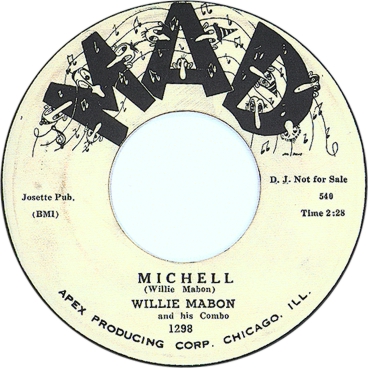
The matrix numbers on Mad 1298 are usually said to have started with R, but the prefix in the vinyl looks more like a capital A with a loop added to the top right. In fact, it's a ligatured version of AP for Apex. The labels repeat the three digits but leave off the prefix. On Mad 1298, there is also a Sheldon imprint in the vinyl, indicating that mastering (and very likely recording) were done at the Chess Studios. (Sheldon was Chess's D/B/A for outside work.) Mad 1300 uses the U prefix for the numbers but carries "Apex Producing Corp." on the label. Mad MR-1005, The Best of Mad Records, is a bootleg CD issued in 2003 and sold by Dead Dog Records.
Up through the early 1960s Mabon played regularly in Chicago clubs, but as soul music became more popular he found his work opportunities diminishing. By the 1970s he was making regular trips to Europe, making ever longer extended stays. He died April 19, 1985, in Paris, France.
The session details are from LFP, and the biographical information from Robert Santelli, The Big Book of Blues (New York: Penguin, 1993). Jay Peters is actually present throughout; LFP leave him off Mad 1298 (where he in fact solos effectively on both sides).
Oscar Brown Jr. (voc); unidentified accompaniment.
poss. Universal Recording, Chicago, 1960
| U-971 | But I Was Cool (Brown) | Mad 1299 | |
| U-972 | Three Squares and a Bunk (Brown) | Mad 1299 |
Mad 1299 carries a credit to Apex Producing Corp. on the label.
This is Oscar Brown Jr.'s first recording. His first LP would follow on Columbia in 1960; he made ten more LPs for Columbia and Atlantic from 1961 through 1974.
Brown was born October 10, 1926 in Chicago, the son of a lawyer. After working as a disc jockey in the early 1950s and serving in the U.S. Army from 1954-56, he entered the world of the performing arts. His interest was in writing songs with a social or political theme, and he often presented them in self-written, self-directed musical plays. Brown's music touches on the world of jazz, folk, and soul, often putting lyrics to jazz instrumentals. While we have not heard these two sides, the titles suggest that Brown fit socially conscious hipster lyrics to a jazz accompaniment, possibly by a Tommy Jones ensemble. "Three Squares" might be about life in the military. Brown reprised "But I Was Cool" for Columbia in 1960 and for Atlantic in 1974. Brown ran unsuccessfully for a seat in the Illinois legislature on one occasion, and for Congress on another. Although his recording career ended in the 1970s, he continued to perform and act in plays and cabaret performances, sometimes working with his daughter, singer Maggie Brown. Oscar Brown, Jr., died in Chicago on May 29, 2005, after a brief illness.
Our discographical information on Brown is from Lord's Jazz Discography. Our biographical information comes from the Guinness Encyclopedia of Popular Music (Middlesex, England: Guinness Publishing, 1992) and "Singer, songwriter Oscar Brown, Jr. dies," Associated Press, May 29, 2005 (http://www.suntimes.com/output/entertainment/29brow.html).
Oscar Brown Jr. was survived by four daughters and one son. A second son, Oscar Brown III, played bass and piccolo bass with Phil Cohran's Chicago-based ensembles and with the Sun Ra Arkestra of the 1980s. Oscar Brown III died in the late 1990s.
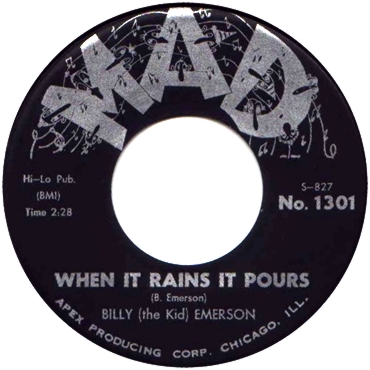
Billy Emerson (voc, p) with Riley Hampton (ldr); John Neely (ts); Little Bobby Neely (ts); McKinley Easton (bars); "Chico" (eg); Wilburn Green (eb); Jimmy Cottrell (d). [The vocals were re-recorded in 1966/7 for Tarpon and Chirrup; unidentified vocal group -1].
Universal Recording, Chicago, March 24, 1960
| 60-1840 | It Do Me So Good | unissued | |
| x-16614 | It Do Me So Good | Tarpon 6606 | |
| 60-1841 | I Took It So Hard | USA 777 | |
| Ex-1034 | I Took It So Hard | Chirrup 0002, Tarpon 6001 | |
| [60-1842] S-827 (AP-827) |
When It Rains It Pours (Emerson) | Mad 1301, Mad MR-1005 [CD] | |
| X-16613 | When It Rains It Pours-1 | Tarpon 6606 | |
| [60-1843] S-826 (AP-826) |
I Never Get Enough (Emerson) | Mad 1301, Mad MR-1005 [CD] |

The original master numbers and the studio group led by Riley Hampton were long taken to indicate that the session was made for Vee-Jay, where Emerson had been under contract previously. (Leadbitter and Slaven indicate that Riley Hampton played alto sax, but none in audible on Mad 1301 and other sources indicate that by 1960 Hampton had quit playing to concentrate on arranging.) However, Vee-Jay didn't get to 1800 in its hybrid matrix series with the two digit prefix for the year till well into 1961.
60-1842/3 were mastered on Mad as S-827 and 826 on the label, AP-827 and 826 in the vinyl (where S probably stands for "Sheldon," the name that Chess used for studio work and mastering done for outside customers, and AP stands for "Apex," rendered as a capital A with the top loop of a capital P grafted on). Mad MR-1005, The Best of Mad Records, is a bootleg CD issued in 2003 and sold by Dead Dog Records.Billy "the Kid" Emerson was born William Robert Emerson in Tarpon Springs, Florida, on December 21, 1929. His first recordings were made with Sun Records in Memphis in 1954-55, when he cut "Red Hot," which subsequently became a rockabilly staple. Next, he recorded three sessions for Vee-Jay with the Al Smith band during 1955-57. 1959 saw Emerson recording for Chess. At all three labels he recorded a version of "When It Rains It Pours."
Emerson recovered these tapes after Bill Sheppard moved to Vee-Jay and the Apex-Mad-Dempsey complex collapsed in 1962. He subsequently recorded on USA, M-Pac!, and Constellation, as well as his own Tarpon label.
Our session details are from Leadbitter and Slaven (1987). LS spell Green's first name as "Wilbur" but this is surely the same musician who played the "electronic bass" in Sun Ra's Arkestra during 1955-1956.
In 1960 Tommy Jones opened a subsidiary label called M&M. In 1962 the Apex-Mad-Dempsey complex broke up after Bill Sheppard pulled out to join Vee-Jay. Jones sustained his operation by continuing to release his productions on the M&M imprint.
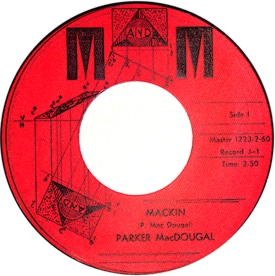
E. Parker McDougal (ts); unidentified (p, b, d).
Chicago, 1960
| 1223-2-60 | Mackin [Dougal] (McDougal) | M&M J-1 | |
| 1223-3-60 | Foxxy Minor (McDougal) | M&M J-1 |
E. Parker McDougal superbly represents the Chicago's "tough tenor tradition," so his very first session as a leader is well worth hearing. Tom Lord breathes not a word of it, mentioning just the two LPs McDougal recorded for his own Grits label in 1974. McDougal recorded his own composition "Foxxy Minor" for his Initial Visit LP on Grits later, and issued a 45 from the LP (Grits 1018) with the same piece on it. His 1960 recording is much slower than the Grits version, which uses a Latin rhythm.
On some copies of the M&M J-1, 1223-2-60 is titled "Dougal." This seems to be "Mackin" under a more dignified title; Dan Ferone has actually turned up a copy of the 45 on which the "Mackin'" title is crossed out by hand and "Dougal" written in. What we do know is that "Dougal" is not the same piece that was titled "Mackin" on the Grits LP, though both are blues riff pieces with some elements in common. Thanks to Dan Ferone for alerting us to the title variation and to Armin Büttner for further information about this M&M J-1.

The saxophonist was born Elmer Parker McDougal on August 6, 1924; after shedding the Elmer, he would wryly refer to his initial E. as a "ghost note." He attended high school at Englewood and college at North Carolina Central University. McDougal began working with bands in the 1940s, chiefly Sonny Thompson's, but he didn't get onto any of Thompson's recordings. McDougal's first recorded appearance was on four sides with pianist Johnny Perry for Rondo in 1949. Besides Perry, McDougal is the main soloist on these sides and the strong instrumental work outweighs Perry's thin, listless singing. During 1955-56 McDougal was in Johnny Griffin's combo (he and Griff unfortunately did not record together, or they could have become as celebrated as Griffin and Lockjaw Davis would be later on). In the 1970s he opened a label of his own called Grits, which released two LPs and at least one single featuring him. McDougal never developed a name until the 1980s, when he became close to an annual performer at the Chicago Jazz Festival (begun in 1979). For much of his life he worked full-time day jobs, as a teacher in the Chicago public schools and then as an employment counselor for the Illinois Department of Employment Security. E. Parker McDougal died on July 18, 1994 at the age of 69.
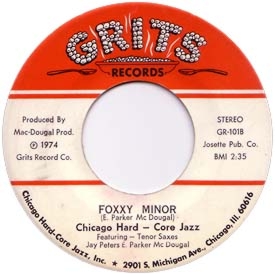
An obit by Kenan Heise, "Jazz Musician E. Parker McDougal, 69," Chicago Tribune, 23 July 1994, provided the biographical details. Eric LeBlanc provided E. Parker's precise dates.

Jimmie Gilmore (p); Bill Casimir (ts); Lynn Sherrill (eg); Tony Smith (d).
Chicago, late 1960
| 196-1114, L07W-4611 | Mr. John's Cha Cha (Casimir-Smith) | M&M 22 | |
| 196-1115, L07W-4610 | Salem (Casimir-Smith) | M&M 22 |
This session has been dated 1961 (which is the probable year of release) but the RCA Victor-derived matrix numbers in the L07W series indicate mastering and pressing in 1960, toward the end of the year. "Salem" and "Mr. John's Cha Cha" are two instrumentals that are very much in the jazz vein. "Salem" is a driving number whereby Smith executes a sharp steady beat behind the Casimir's loping sax work, while "Mr. John's Cha Cha" takes a more syncopated approach.
In the 1960s the band played such clubs as Allegretti's (at Mannheim and Higgins) and the Cairo Supper Club (4015 North Sheridan). Too many years in toney supper clubs had taken the edge off the group by the time they started putting out their own LPs (see the first Tony Smith session for details).
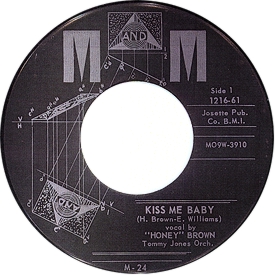
Honey Brown (voc); Tommy Jones Orchestra: Tommy Jones (ts, ldr); Jack Wilson (p); Roland Faulkner (eg); Donald Raphael Garrett (b); Harold Jones (d).
Webb Recording Studios, Chicago, 1961
| 1216-61 M09W-3910 |
Kiss Me Baby (Honey Brown-E. Williams) | M&M-24 | |
| 1215-61 M09W-3911 |
The Glory of Love (Hill) | M&M-24 |
The RCA Victor numbers with the M prefix show that this session was mastered and pressed in 1961. The 1200 series numbers suggest that these sides were recorded at the same session, or in the same cluster of sessions, as the instrumental items listed under Mad21 below. A listen to M&M 24 (finally, in June 2022) confirms the same band lineup as on M&M 25.
Chicago-based Honey Brown had been around since at least 1937, when she was performing as a dancer-singer in Toledo and Chicago. She worked in Detroit most of the 1940s as a blues singer, so her next sighting in Chicago was in August of 1948, when she was booked in a revue at the Club DeLisa. Her first recording opportunity consisted of four sides she did in 1950 for the New York-based Derby label; two were with the Freddie Mitchell Orchestra and two were with the Edward Johnson Orchestra. In 1956, Brown was recorded by Jimmie Davis for his Club 51 label. These Mad sides were unknown until a few years ago, when Dr. Robert Stallworth visited her and obtained the recording (Stallworth remembers her as a very gracious and elegant lady).
Each side of M&M 24 preserves a performance that would be impossible to improve on. It reminds us of the indispensable contributions that, functioning at their best, even the tiniest indie record companies could make. Honey Brown is in good voice, singing with the kind of verve that had made her popular on stage. Tommy Jones solos on both sides.
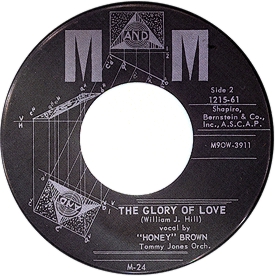
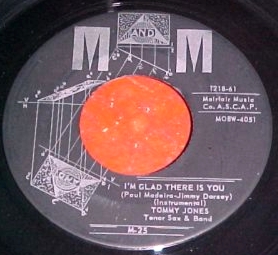

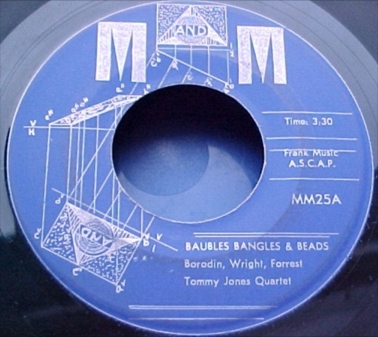
Tommy Jones (ts); Jack Wilson (p); Roland Faulkner (eg); Donald Raphael Garrett (b); Harold Jones (d).
Webb Recording Studios, Chicago, 1961
| 1217-61 MO8W-4050 TJ-1B^ |
F.A. (Jones) | M&M M-25, M&M TJ-1B^, M&M LM-27, Mad A1 [CD] | |
| 1218-61 MO8W-4051 MM25B TJ-2S* |
I'm Glad There Is You [I'm Glad There's You*] (Madeira-Dorsey) |
M&M M-25, M&M MM25B*, M&M LM-27, Mad A1 [CD] | |
| MM25A TJ-1S |
Baubles Bangles & Beads (Borodin-Wright-Forrest) | M&M MM25A*, M&M LM-27, Mad A1 [CD] | |
| Snowfall (C. Thornhill) | M&M LM-27 | ||
| Ghost of a Chance (V. Young-N. Washington-B. Crosby) | M&M LM-27 |
Two different 45-rpm singles were released as M&M 25.
The coupling of "F. A." and "I'm Glad There Is You," on a black-label M&M, appeared first, because of the matrix numbers employing the RCA Victor custom pressing code for 1961. The blue-label single that replaces "F.A." with "Baubles, Bangles, and Beads" has less contentful matrix numbers and appeared later, not in a way that would help us figure the exact date.
The black-label M&M 25 that uses "F.A." on one side was brought to our attention by Dan Ferone, who provided the label and title information. A copy now resides in the collection of Dan Kochakian. The 1200 series numbers appear on the label; the M prefix matrix numbers (which indicate mastering and pressing by RCA Victor in 1961) are stamped on the vinyl. The 1200 series numbers further suggest that these two sides were recorded at the same session as the Honey Browns.
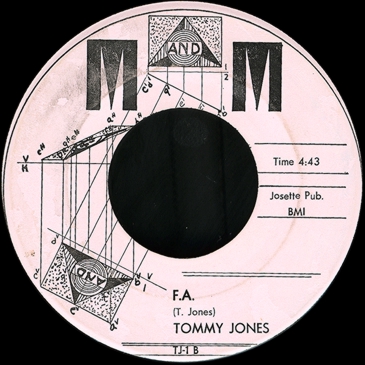
In the the 1970s, "F.A." reappeared on M&M TJ-1B, with "Egg Nog" from the Mama LP (session Mad45) as its A side. (Some sources have listed this later single as M&M 1A b/w 2A, but we haven't seen any that were numbered that way.) "F. A." is a ballad performance obviously influenced by John Coltrane's work of the 1959-1961 period—another sign of Tommy Jones' wide-ranging interests. Accompaniment is by piano, guitar, bass, and drums; the piece runs to just under 5:00.

We once listed an M&M 258, with the very same A and B sides as the second, blue-label M∓M 25. At this point we're inclined to discount 258 as a misreading of 25B, but a collector could prove us wrong about that.
"F. A.," "I'm Glad There Is You," and "Baubles, Bangles, and Beads" from this session were also used, and "Snowfall" and "Ghost of a Chance" appeared for the first time, on what was probably the second M∓M LP (after the George Green effort described below). This was A Different Sound, released in 1963 or later as M&M LM-27. On it the artist and label proprietor went as Madman Jones, and Jack Wilson is credited as the co-composer of "F. A." The personnel and location for the session are taken from Bob Schwartz's notes to the LP. The other 5 tracks on the LP came from a session, most likely recorded a couple of years later, with a group that included Willie Jones at the piano (see Mad24a below).
Finally, three of the titles listed here appeared on Tommy Jones' last production, a CD on Mad A1 that appeared in 1991 while he was living in Amsterdam. The CD was titled Tommy "Madman" Jones & His Friends: Chicago Style 1960 [sic]-1976 [also sic]. We have now verified that "Fa" on the CD is the same track as "F.A." on the earlier releases. Jones' own notes to his CD mention the pianist and bassist—but not the guitarist and drummer.
"F.A." has prominent work by guitarist Roland Faulkner, who solos after Jack Wilson's piano. There is also a guitar solo on "Baubles Bangles and Beads," and Faulkner is present (quietly) on "I'm Glad There's You" (rendered "I'm Glad There Is You" on the CD).

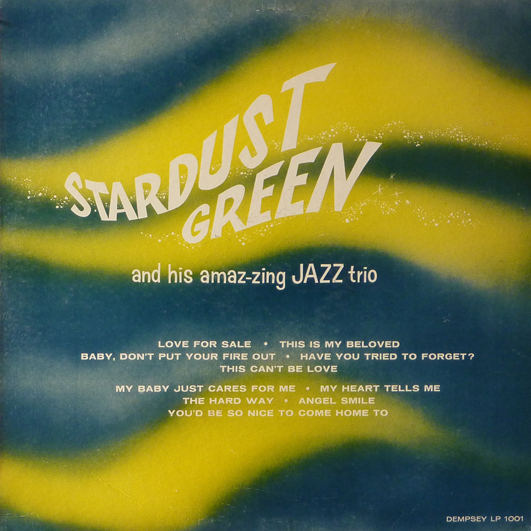
George "Stardust" Green (voc, d); Robert Knowles (p); Dolphus Dean (b).
Chicago, between 1960 and 1962
| Love for Sale (Porter) | M&M / Dempsey LP-1001 | ||
| This Is My Beloved (Revel-Horwitt) | M&M / Dempsey LP-1001 | ||
| Baby, Don't You Put Your Fire Out (Dean) | M&M / Dempsey LP-1001 | ||
| Have You Tried to Forget? (Pate) | M&M / Dempsey LP-1001 | ||
| This Can't Be Love | M&M / Dempsey LP-1001 | ||
| My Baby Just Cares for Me (Donaldson-Cohn) | M&M / Dempsey LP-1001 | ||
| My Heart Tells Me (Warren-Gordon) | M&M / Dempsey LP-1001 | ||
| (You Had to Learn) The Hard Way (Anderson) | M&M / Dempsey LP-1001 | ||
| Angel Smile (Smith-Dixon-Keyes) | M&M / Dempsey LP-1001 | ||
| You'd Be So Nice to Come Home To (Porter) | M&M / Dempsey LP-1001 |
Rediscovered not too long ago is George "Stardust" Green's first LP, from the days of the Mad/Dempsey/Apex combine. We don't know the year, but an LP identified as Dempsey LP 1001 on the front cover and M&M LP-1001 on the labels can't be earlier than 1960 or later than 1962.
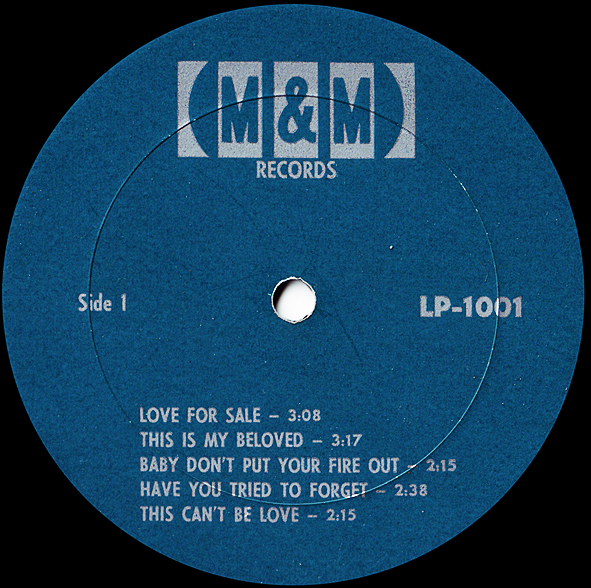
Tommy Jones obviously thought well of the Green trio, because he stayed with them after parting from Dempsey and Apex. The group's second LP would be an exclusve M&M product.
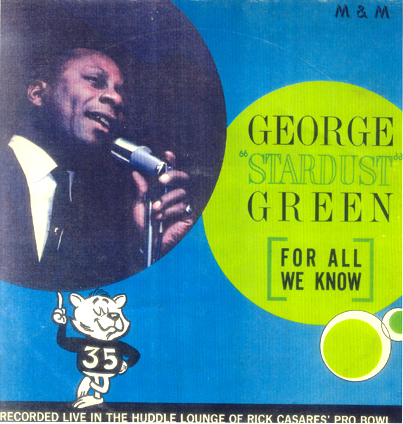
George "Stardust" Green (voc, d); Robert Knowles (p); Dolphus Dean (b).
Huddle Lounge, Buffalo Grove, IL, ca. 1963; *unidentified studio, Chicago, ca. 1963
| For All We Know | M∓M LM-26 | ||
| My Romance | M&M LM-26 | ||
| MM 1001 B | You're Mine You (Green) | M&M LM-26, M&M XLM 26* | |
| Early Autumn | M&M LM-26 | ||
| Come Rain or Come Shine | M&M LM-26 | ||
| Moon River | M&M LM-26 | ||
| I'm a Fool to Want You | M&M LM-26 | ||
| MM 1001 A | It's My Heart Again (Small-Small) | M&M LM-26, M&M XLM 26* |
The third LP to come out of Tommy Jones' operations was called For All We Know and was recorded live in the Huddle Lounge of Rick Casares' Pro Bowl club, in Buffalo Grove, Illinois, sometime around 1963. George "Stardust" Green, who obviously derived his name from the Hoagy Carmichael ballad, had been a lounge singer in Chicago since the mid-1940s, and, on this LP as well as the previous one, most of his material consisted of ballad standards.
Green was born in Chicago on September 6, 1923, and grew up on the West Side. After his discharge from the U.S. Army in 1943, he returned to the city to perform in clubs. He divided his career between serving as a drummer in jazz combos and fronting bands as a standup nightclub singer.
He appeared on a private recording of the King Fleming combo from April 1952, probably already being featured as a vocalist. His first commercial recording that we know of was with the Jimmy Binkley Quintet on Chance in 1953, when label owner Art Sheridan wrote him a blues, "Finance Man," and he also sang "Brand New Rockin' Chair." However, by this time he was already appearing in clubs with his "Stardust" moniker, which he either got from his nightclub repertoire or from an earlier, untraced recording of his—we simply don't know. In 1953, for example, he was billed at the tony Paris Club (1519 West Madison) as "George 'Stardust' Green (The Voice)" and at Martin's Corner (1900 West Lake) as George 'Stardust' Green (M.C. and vocalist)".
In the mid-1950s Green was playing drums in combos, notably in King Fleming's trio, in the Morris Ellis band, and with Ramsey Lewis and Eldee Young before they picked up Red Holt. Meanwhile, in standup mode, Stardust Green (no George on the labels this time) made a 45 that we've just noticed in 2022, for a short-lived record company out of Peoria, Illinois, called Tempus. Tempus TR 1509, most likely made early in 1959, features Green singing "Ain't You Gonna Love Me" and "I Hug My Pillow," both written by one Robert Sweetwater (possibly the alter ego of a studio guitarist, Ronald Steele) and accompanied by a band (piano, guitar, bass, and drums) directed by the same. Green was making a decent shot at rock and roll, which is what both Tempus sides are. The commercial response didn't encourage him to make further attempts. A Defender story from May 23, 1963, has Green fronting his own trio on drums and vocals, along with Dolphus Dean on bass, and Bob Knowles on piano. The paper said the trio had been together for six years. We figure that the LP (and the associated single on M&M XLM 26) probably came out around the time this story was published.
For All We Know is an all-ballad LP on which Green does the full lounge lizard. The recording has the distant echoey sound one finds in many early homegrown live LPs that were sold off the stage, as obviously this one was meant to be. Green vocalizes with some jazz sensibility on "Come Rain or Come Shine," but the other numbers hold little interest, even for fans of the lounge gballad. The accompaniment by Knowles and Dean typifies cocktail lounge jazz in its tastefulness—and its lack of excitement.
In 1962 or 1963, Green tried his hand at rhythm and blues for a company called Mac-An. One of the sides, believe it or not, was a very early cover of Bob Dylan's "Blowin' in the Wind"; on the Mac-An, Green resumed his affiliation with King Fleming. A Rivlyn EP, made in 1963, has Green demonstrating four songs by local songwriters; there is also at least one regular Rivlyn 45 with two of these songs on it. King Fleming co-arranged and conducted the band. A Gateway single (made around 1964) has Green singing with a bit of jazz swing to Harold Betters' funky number "Do Anything You Wanna." A release on F-M from around 1970 features Green as a ballad singer; King Fleming, with whom Green was working on gigs at the time, played piano and did the arrangements. A 45 rpm single from 1975 or later, on FM & PM 1111, has Green slogging his way through an awful version of Morris Albert's "Feelings," as arranged by label proprietor Floyd Morris (all right, has anyone ever done a good version of "Feelings"?). In 1982, Green compiled 3 of his released F-M and FM & PM tracks, along with other material of similar origin, on a final LP, released on his own label.
George Green retired from performing in the early 1990s because of heart trouble. He died in his home in Henderson, Nevada, on March 11, 2007.
Sources: Larry Finley “George ‘Stardust’ Green 1923-2007: Chicago Jazz Singer,” Chicago-Sun Times, 23 March 2007.

O.C. Logan, Willie Logan, Arthur Ford, Dave Hoskin (vocals); unidentified (p); unidentified (eg); unidentified (b); unidentified (d).
Chicago, 1962
| 2314-62 N90W-9667 |
In between Tears (O. C. Logan) | M&M M-30, Mad MR-1005 [CD] | |
| 2315-62 N90W-9668 |
Beneath the Sun (W. Logan)* | M&M M-30, Mad MR-1005 [CD] |
The additional "l" in the name must have made a difference. "Beneath the Sun" b/w "In between Tears," released in 1962 (the date is confirmed by the N series numbers from RCA Victor), was an improvement over the group's previous release. Mad MR-1005, The Best of Mad Records, is a bootleg CD issued in 2003 and sold by Dead Dog Records.
"Beneath the Sun" goes for baroque in its exaggerated contrast between the hysterical screaming falsetto and the comic bass work. "In between Tears," an uptempo number despite the title, features some intricate rhythms, not always cleanly executed. Going baroque did not generate any sales, and in 1962 the group signed with George Leaner's One-derful label. Much to the Equallos' dismay, however, he never put anything out on them.
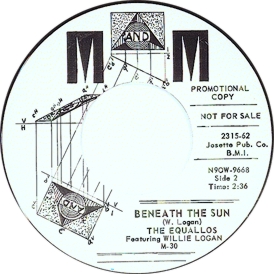
Rumor has occasionally had it that Sun Ra was involved with this session (the Side B title may have encouraged someone to seek a connection, as did the rather approximate accompaniment on wood blocks). While Sunny rehearsed and directed several doo-wop groups, recording some of them for his Saturn label and one for Pink Clouds, his vocal group activity ran entirely in two waves, 1954-1955 and 1958-1959, and he was no longer in Chicago when this session was made.
In 1963 the Equallos recorded as Willie Logan and the Plaids, making a two-sided neo-doowop single called "You Conquered Me" b/w "Say that You Care," which appeared on Jerry Murray's Jerry O label. The two thinly-produced sides with their exotic warbling (a bit off-key besides) sounded dated next to the soul sounds that were emerging.

Unidentified vocal group; unidentified (p); unidentified (eg); unidentified (b); unidentified (d).
Sheldon (Chess) Studio, Chicago, c. 1962
| S-3001 | Nursery Love (Little Prince) | M&M 1263, LG 7020, Mad MR-1005 [CD] | |
| S-3000 | Say It (Freddie W.)* | M&M 1263, LG 7020, Mad MR-1005 [CD] |
M&M 1263 is an ultra-rare vocal group record. There is a Sheldon stamp in the vinyl, indicating that Sheldon (i.e., Chess) did the mastering and pressing. The S prefixes may further indicate that the session was recorded at the Chess studio. LG 7020 is a bootleg CD anthology called A Million Dollars Worth of Doo-Wop Vol 6; it was released in 1995. The CD said the release came out in 1963, but the date could have been a year or two earlier. Mad MR-1005, The Best of Mad Records, is a bootleg CD issued in 2003 and sold by Dead Dog Records.
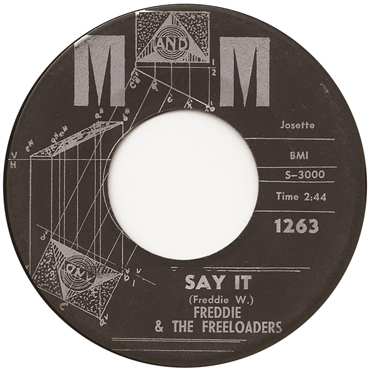
A previously unknown track, apparently recorded for Mad or M&M, appeared on Mad MR-1005, The Best of Mad Records, a bootleg CD released in 2003 and sold by Dead Dog Records. The title is "Tell Me Why" and the artist is listed as Johnny Holliday. The contents are a sentimental ballad sung by a rather quavery tenor, along with a bass singer, female backup singers, and accompaniment by piano, guitar, bass and drums. This may be the same Johnny Holiday who recorded an operatic pop single for United in 1953 with string-heavy backup, though if so he had undergone some decline in the vocal department.
Does anyone know more about this? Presumably it was released on a 45-rpm single, as nothing on the bootleg Mad CD appears to have come from master tapes.
A session previously unknown to us produced the tracks used on Side B of Tommy Jones' album A Different Sound. These are the first that he recorded with pianist Willie Jones. Willie Jones would work frequently in Tommy Jones' combos during the 1960s and early 1970s.
Tommy Jones (ts); Willie Jones (p); Leo Blevins (eg); Betty Dupree (b); Marshall Thompson (d -1); Gil Gray (d -2).
Webb Recording Studios, Chicago, poss. 1963
| Willow Weep for Me (Ronell) -1 | M&M LM-27 | ||
| Since You've Been Gone (T. Jones) -1 [Fleur^] | M&M LM-27, M&M TD-5516, Mad A1 [CD]^ | ||
| Slow and Low (T. Jones-W. Jones) -2 | M&M LM-27 | ||
| Simp Green (T. Jones) -2 | M&M LM-27 | ||
| Not Yet (T. Jones) -2 | M&M LM-27 |
This session contributed five tracks to M&M LM-27, A Different Sound Since LM-27 follows George Green's LM-26 in the catalog number series, and the other five tracks on LM-27 appear to have been recorded in 1961 (they were from session Mad21 above), we have estimated the recording date here as 1963. It's a minimum—the date could be later.
Our information about the session comes from Bob Schwartz's notes to the LP, which was brought to our attention by Dick Shurman, and covered in an article by John Corbett (on worthy LPs that have yet to be reissued on CD) in Down Beat, December 2004.
The "Since You've Been Gone" on Tommy Jones' last LP Bow Legs (M&M TD-5516) is a reissue of this version. On the liners to that LP George Freeman is identified as the guitarist and William "Bugs" Cochran as the drummer; Phil Thomas is added on congas. We are going with the notes to A Different Sound, which were much closer in time to the actual recording. (See sessions Mad47 and Mad53 below for the rest of the LP; we used to list "Since You've been Gone" from the Bow Legs LP and "Fleur" from the Mad CD compilation as coming from a Mad48.) It reappears (in stereo; LM-27 was released in mono) as "Fleur" on Tommy Jones' last production, a CD issued in the Netherlands in 1991 and titled Tommy "Madman" Jones & His Friends: Chicago Style 1960-1976. None of the other tracks from this session appear were released anywhere else.
Marshall Thompson is the drummer on two ballads ("Since You've Been Gone" and Willow Weep for Me"). Gil Gray takes his place on two rock numbers, "Simp Green" and "Not Yet," and the blues "Slow and Low." Bob Schwartz's notes state that "Simp Green" had a dance step to go with it, which Tommy Jones's son was promoting on the South Side. It sounds like a boogaloo.
Willie Jones does not solo on "Since You've Been Gone" (a ballad performance that clocks in under 3 minutes and features Tommy Jones throughout) but takes a characteristically cascading solo on "Willow Weep for Me." He also solos on "Simp Green" and "Not Yet." He would make one more session with Tommy Jones (Mad47, which so far as we know was Willie's last).
We previously listed a single by one Marvin Murphy (supposedly M&M 103, titles rendered as "Cryin' for My Baby" b/w "Tears Falling") here as Mad25. However, Andy Bohan (email of February 4, 2013, follow-up on March 23, 2013) has informed us that this is a misidentification of a single on MM 103. MM was a Los Angeles based label of the early 1960s, unconnected with the Madman Jones operations. According to Bohan, MM 103 actually had for its A Side "Crying for My Baby" by Marvin Murphy. The B side was "Tears Falling from My Eyes" by Marvin Murphy. MM 104 was by a group called the El Rays—not the same El Rays in Chicago who soon became the Dells.
Jones could not get anything going with any of his releases, and found himself increasingly angry and embittered by the experience. Said he, "I gave my records to [distributor] Ernie Leaner, and for some stupid reason I trusted the guy. I've never been a businessman, and I took my releases to him and he didn't do a doggone thing with my stuff. I sent a few records outside of Chicago, but never received any kind of encouragement from anybody. Deejays were taking money then, and I remember saving up 300 dollars and giving it to a disc jockey. He played my record twice, and I just got disgusted completely. It was horrible. I remember sitting at the back of my third-floor apartment and just taking records and sailing them into the alley, because they weren't selling."
Jones lingered on from the early 1960s, largely with his M&M label, but never got even a local hit.
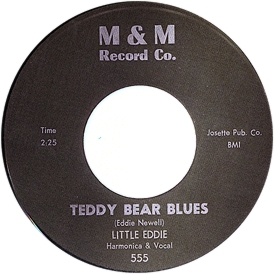
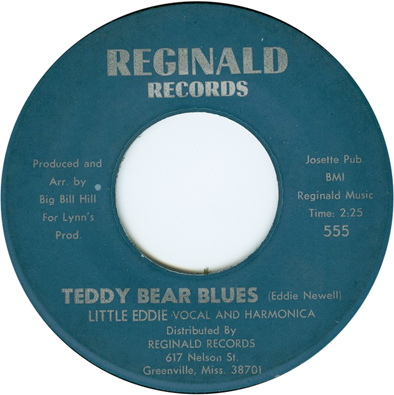
Eddie Newell, (voc; hca-1); with unidentified (org); Eddie Taylor (eg); Hubert Sumlin (eg); W.W. Williams (d).
Chicago, 1968
| 555 | Teddy Bear Blues (Newell) | M&M 555, Reginald 555 | |
| 556 | The Skrooch -1 (Newell) | M&M 556, Reginald 556 |
Little Eddie, born Eddie Newell on August 29, 1930, was a blues harmonica player and vocalist. He died in St. Louis on April 24, 1981. For this session he was able to get a good band, but it didn't help him much. "Teddy Bear Blues" is a routine 12-bar item. Eddie's vocals are undermixed, and there is a decided lack of energy in the proceedings. "The Skrooch" is a novelty instrumental, mildly better, but it does not sustain interest enough for repeated listening. M&M 555/556 was one 45-rpm single with different release numbers on the A and B sides.
The M&M release was coordinated with a release on Reginald, a company out of Greenville, Mississippi. The labels to the Reginald indicate that Big Bill Hill, the noted blues disk jockey, produced the session. Supervising sessions wasn't Big Bill's strong suit; the recording and mixing on this session are distinctly amateurish.
We got our session details came from Mike Leadbitter, Leslie Fancourt, Paul Pelletier (LFP), Blues Records 1943-1970, Volume Two, L to Z (London: Record Information Services, 1994).

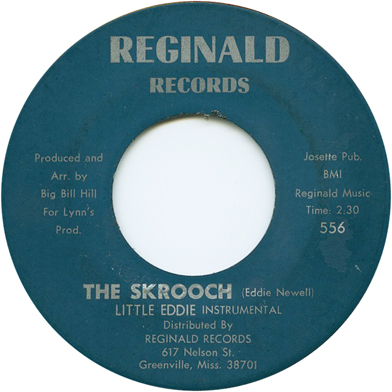
In 1968, Jones revived his Mad imprint, reusing the 1200 number series. (In fact, the first "new" Mad single reused number 1201. In a little while 1203, 1204, 1205, and 1207 would be recycled as well.) What came out of this new project was pretty dire, however. There was little jazz interest, or rhythm and blues interest, to any of it. A contemporary spasm of activity on the M&M label did bring more jazz-oriented fare, by Jones himself, the Prince James Quartet, and Clarence Wheeler and the Enforcers.

Joe Subway (patter); unidentified (fl -1; ts -2); unidentified (p, eg, b, d); two unidentified females (bg voc -1).
prob. RCA Studios, Chicago, 1960
| M 111, L0-7W 0670-1 | Mudder Goose (Subway) -1 | Mad 1201 | |
| M 112, L0-7W 0671-1 | How to Sell Stereo (Subway) -2 | Mad 1201 |
Not a good way to sell stereo! Joe Subway tries to milk comedy out of pretending to be a beatnik. On "Mudder Goose" he mutilates nursery rhymes to a calypso background. "How to Sell Stereo" features some ineffectual salesmanship with jazz accompaniment. The musicians are obviously professionals; with the doubling on tenor sax and flute, one wonders whether Prince James might have been involved. As for the salesmanship... "How does stereo work? I guess the 'ster' comes out the left speaker and the 'eo' comes out on the right" doesn't sound any better than it reads.
The release date is said to be 1968 and the psychedelic label pattern bears this out. But the material had obviously been in the can for a long while. The L series matrix numbers from RCA Victor indicate a 1960 recording date, Joe Subway gives the year as "1960" on "How to Sell Stereo" (stereo was on the way in at the time) and there were no beatniks left when the record finally saw release.
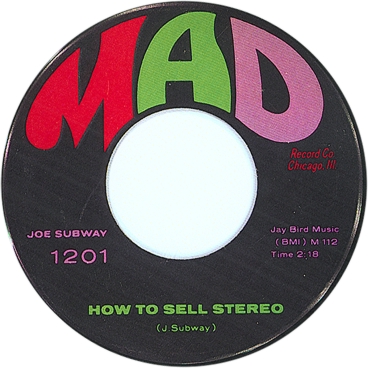
Danny (voc, g); Jana (voc, g).
Chicago, 1960s
| A-114 MPCOA-1001-A |
Schuss Mountain | Mad 1202 | |
| B-114 MPCOA-1001-B |
Shot an Arrow | Mad 1202 |
Danny and Jana, we now learn from a copy of Mad 1202 in Armin Büttner's collection, were a 1960s folk duo. Both played acoustic guitar and Danny had a somewhat stronger voice (Jana sometimes prefigures Melanie Safka). Who brought them to Tommy Jones' attention we have no idea.
One of the titles on Mad 1204 and both sides of Mad 1205 by the Apocryphals (see next session) were published by Schuss Music. Could there be a connection?
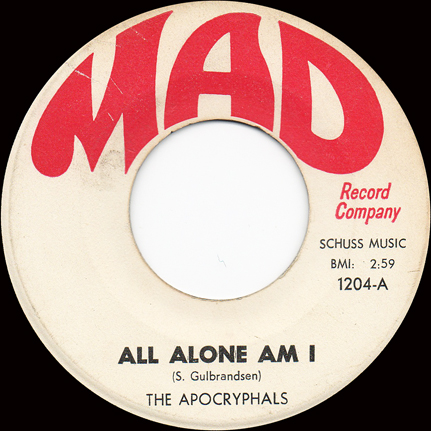
Personnel unidentified.
MBS Studio, Chicago, late 1960s.
| 115A | Baby, I Know I'm Losing You (Whitfield-Holland-Grant) | Mad 1203 | |
| 115B | Mickey's Monkey (Holland-Dozier-Holland) | Mad 1203 | |
| 1204-A | All Alone Am I (Gulbrandsen) | Mad 1204 | |
| 1204-B | Knock on Wood (Floyd-Cropper) | Mad 1204 | |
| 1205-A | Little Man (Gulbrandsen) | Mad 1205 | |
| 1205-B | Images (Sordelli) | Mad 1205 |
The top side of 1203 is the same song as the Temptations hit, and the bottom side is the same song as the Miracles hit. On the more recently rediscovered 1204, for which we are indebted to Mark Hanson, one side is an Eddie Floyd hit. Mad 1203 (the second single with this number) has matrix numbers in a short series that it shares with the new 1202; 1204 (again, the second release with this number; first Mad 1204 was from Tommy Jones' first session for the label in 1956) is strictly an A and B release. However, in the trailoff area there is an MBS prefix to the Mad 1204-A, indicating the studio that Jones was using. Tommy Jones had apparently decided to try a Motown kick, since nothing else was selling.
Mad 1205 (again, reusing a number from Tommy Jones's first session) was brought to our attention by Joel Mills (email, July 23, 2017). It has a second composer credit to Gulbrandsen, who published with Schuss Music, and one to Sordelli, who published with the same entity. There is no MBS marking in the runoff areas to 1205, but on Side A there is MAD 1205-A followed by a delta and a pi and TM-2830, and on Side B one will find MAD 1205-A [sic] delta pi TM-2829.
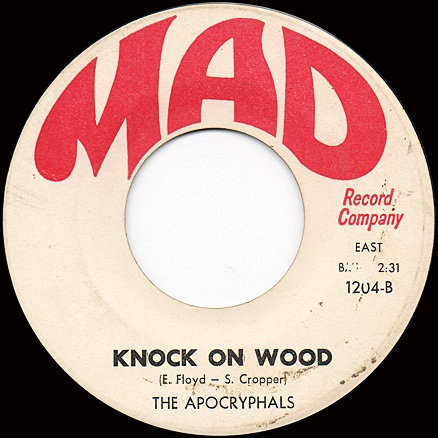
Muisicians unidentified.
Chicago, 1968
| 1206-A | Enough for Everybody (Garner-Boyd-Dickerson) | Mad 1206 | |
| 1206-B | Permanent Vacation (Forest) | Mad 1206 | |
| 1207-A | Deaf, Dumb, & Blind (Ram) | Mad 1207 | |
| 1207-B | Never Get Enough (Miller) | Mad 1207 |
These sides are highly untypical of a Tommy Jones label. Two were outside productions done by producer Emmett Gardner with arrangements by Donny Hathaway; the other two were produced by Buck Ram. This is a group, not a solo female artist, and it sounds like a soft rock band, given a standard soul-style orchestrated production. These 45s were pretty common in Chicago cutout bins in the 1970s, leaving one to believe that Jones overanticipated demand.

Tommy Jones (ts); Jack DeJohnette (p); C. Roberts (b); Curtis Prince (d).
Jack DeJohnette's living room, Chicago, possibly 1964
| 1241 URJ | Groovy Blues Side One | M&M1241 | |
| 1242 URJ | Groovy Blues Side Two | M&M 1242 |
M&M 1241/1242 is a fine specimen of soft bebop, where the melody is engaged a bit more and the little bit of improvising makes the record interesting.
According to George Korval, who got Jack DeJohnette to autograph a copy, "Jack told me that he had just bought a tape recorder and this 45 was recorded in his living room! He said that Tommy wanted to make a 'jazz' record instead of what Jack called 'commercial' records he had been making" (email of February 19, 2013). Korval has given August 1964 as the recording date (DeJohnette made his recording debut in December 1963), but this needs verifying.
Though his latter-day fame is as a drummer, Jack DeJohnette started out as a pianist and at one time led a trio in Chicago. In 1960-1961, DeJohnette (alternating between piano and drums in a duo with bassist Scotty Holt) was the intermission act at the Wonder Inn, where Sun Ra and his Arkestra frequently topped the bill.

Clarence Wheeler (ts); Sonny Burke (org); other musicians unidentified.
Chicago, late 1960s
| CW-1A | Doin' What I Wanna (C. Wheeler-J.S. Burke) | M&M 1 |
| CW-2B | BINGO! (C. Wheeler-J. S. Burke) | M&M 1 |
This group is better known as Clarence Wheeler and the Enforcers, who were highly popular in the Chicago clubs during the 1960s and 1970s, playing notably at Lurleans and The Green Mill. Dan Ferone recently confirmed the existence of M&M 1, which we had previously mentioned as an unconfirmed release.
Clarence E. Wheeler was born on July 18, 1933 in Arkadelphia, Arkansas, reportedly from a musical family. His mother gave him his first saxophone when he was still in grade school. At some point during his grade school years his family moved to Chicago. Wheeler graduated from Hyde Park High School, and after attending college briefly entered the Navy, where he played in the Navy Band.
Wheeler formed the Enforcers in the late 1960s, with Sonny Burke serving as mainstay on the organ. During its long stay at the Jazzville Lounge (4742 West Madison) in 1969, the group featured besides Wheeler and Burke, Sonny Covington on trumpet, George Hughes on drums, and Lenny Lynn on vocals. A Chicago Defender blurb for a photo said that the group “rocked with funky soul.” The group performed what was popularly called “soul jazz,” a fusion music that had great popular appeal at the time. During 1970-71, the Enforcers were virtually the house band at Lurleans (319 East 75th). The group also played at Roberts Motel (333 East 63rd) in 1972, and the Toast of the Town (7040 South Stony Island) in 1973. Around this time, Robert Pruter saw the Enforcers play at a club in Chicago's Old Town nightclub district, and found them to be an exciting group, playing very much in the soul-jazz idiom.
Clarence Wheeler (ts); unidentified (tp); unidentified (bars); prob. Sonny Burke (org); prob. George Hughes (d).
Chicago, late 1960s
| CW-3A | Dream Bossanova (E. Buster) | M&M 3 | |
| CW-3B | Miss "G" (Wheeler) | M&M 3 |
"Dream Bossanova," composed by Eddie Buster, is a relaxed number, where the organ and tenor sax provide smooth stylings with just a bit of improvisation. Clarence Wheeler had been in Eddie Buster's band (which would also record for M&M during this period). "Miss 'G'" is a bop-style number in a brighter tempo, much more appealing to jazz ears. Tom Lord makes no reference to either M&M session, but does mention the group's Atlantic LP sessions from 1969, 1970, and 1972, and their Straight Ahead sessions in 1980. He neglects to mention that the Enforcers also recorded (at some point in the 1970s) a single for E. Parker McDougal's Grits label. Clarence Wheeler died on June 7, 2006.
We wonder whether there was also an M&M 2 by the Enforcers...
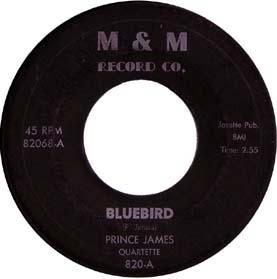
Prince James Narcisse (ts, fl); others unidentified.
Chicago, late 1960s
| 82068A | Bluebird (James) | M&M 820-A | |
| 82068B | Pumpkin Place (James) | M&M 820-B |
There is no mention of this group in Lord, despite the jazz content on the record.
Prince James, whose full name was James Narcisse, was born on February 2, 1932, according to records kept at the Chicago Federation of Musicians; he joined Local 208 on July 3, 1950. According to Dick Shurman, Narcisse was a follower of Gene Ammons. On July 20, 1950 James Narcisse posted a contract with for 3 days at Fuller's Lounge. On July 15, 1954, Local 208 recorded his contract with Club Relax. On November 21, 1957, he posted an indefinite contract with the Memory Ranch Lounge, and on September 18, 1958, he posted another with the Abstract Lounge. In December 1958, his combo was playing on Wednesday and Thurday nights at Budland.

On July 3, 1963, his contract with the Talk of the Town club was accepted and filed; he was identified by this time as "Prince James Narcisse." Prince James remained in Chicago for many years after M&M recorded him, eventually moving to Las Vegas in 1985. He is reportedly deceased, but we lack confirmation of that.
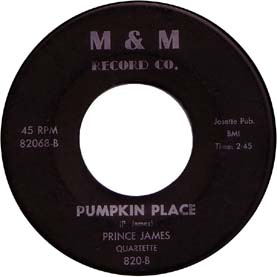
Prince James Narcisse (ts -1; fl -2); unidentified (org); unidentified (d).
Chicago, late 1960s
| 1265A 5997-01A |
My Romance ("Rogers" & Hart) -1 | M&M 1265 | |
| 1265B 5997-01B |
Chicago Style (James) -2 | M&M 1265 |
No mention of this group in Lord either. It should be included, even though Prince James and his sidepeople are purveyors of cocktail lounge jazz. "My Romance" is the Rodgers and Hart standard; it is expertly if not engagingly led by James' smooth tenor sax work and undergirded by organ throughout. The spirited Latin "Chicago Style" is a James original and features his flute work with a bit less organ support. The drums, used sparingly on both sides, are nearly inaudible on the A side.
Tommy Jones (ts); W. Deemus (cga); unidentified (claves); unidentified female (vocal comments)
Chicago, late 1960s
| 31566-01 A | Tommy's Here (Jones-Deemus) | M&M 1266 | |
| 31566-01 B | The Message (Jones-Deemus) | M&M 1266 |
We previously misspelled the name of the group (this rendition may still be misspelled, but at least it agrees with the label copy). Both sides are credited to T. Jones and W. Deemus. Since Tommy Jones is featured on tenor sax, and the other main contributor plays congas, we assume W. Deemus is responsible for the latter. The track also includes another percussionist playing claves and a female vocalist who sighs and praises the performance in the background.
On "Tommy's Here," Jones plays an excellent solo in this unexpected setting—more evidence of his versatile musicianship.
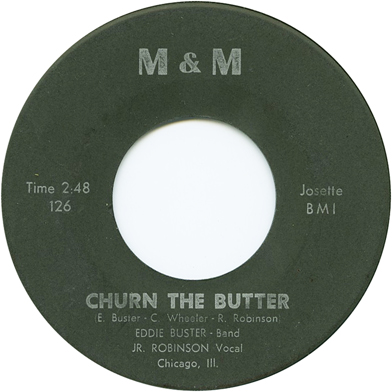
Eddie Buster (org); prob. Clarence Wheeler (ts); prob. Fred Limbo (eg); prob. Richard Smith (d); Jr. Robinson (voc on *)
Chicago, late 1960s
| MM-1267 | Churn the Butter (Buster-Wheeler-Robinson)* | M&M 126 | |
| MM-1267B | Kitchen Cookin' (Frazier-Jones) | M&M 126 |
Eddie Buster had previously worked with Clarence Wheeler (note the writing credit to Wheeler on "Churn the Butter").
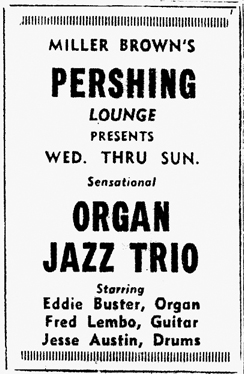
Eddie Buster was born on March 29, 1931, in Bridgeport, Connecticut. He first applied for membership in Local 208 on October 31, 1959, according to records kept at the Chicago Federation of Musicians. Buster was already working 5 nights a week at the Pershing Lounge with Fred Limbo (guitar) and Jesse Austin (drums) when he transferred his Union membership to Local 208; the local didn't impose a delay before he could work on the South Side, as it had previously done with Jack McDuff. In 1960, his trio enjoyed a long run at McKie's Disc Jockey Lounge. Buster played piano and organ, but recorded strictly as an organist. In the early 1960s he appeared on LPs recorded in Chicago by Gene Ammons and Sonny Stitt. We learn from the minutes of the very last Board meeting at Local 208 (January 6, 1966) that Buster had been working with Clarence Wheeler (tenor sax), Fred Limbo (guitar), and Richard Smith (drums). Limbo had been Buster's regular guitarist since he began working in Chicago, and Smith had been in the group for 2 years. Buster had been "erased" from the Local 208 membership rolls for not paying his "Local tax" since April 1965. After the Board declared him "erased" for nonpayment, he got into further hot water for taking engagements at the Coral Club and the Embassy Club. Buster would eventually reapply for membership in the Chicago Federation of Musicians on June 21, 1969.

Jones continued to put out singles on himself. "Manhã de Carnaval" was drawn from an LP; the rest were restricted to 45 rpm.

Tommy Jones (ts); unidentified (org); unidentified (eg); unidentified (d).
Chicago, 1960s
| 114 | Blues for the B's | M&M 114 | |
| 115 | Reddy Freddy | M&M 115 |
Both sides of M&M 114/115, well recorded in a commercial studio, are hard driving jazz funk, where Jones makes use of his barwalking tricks to blow with authority. "Blues for the B's" has a bit more appeal. The combo is identified as "T. J. & The Group" on the label but the producer credit to "Thomas D. Jones" removes any ambiguity. M&M 114/115 is another highly difficult disk to find, but is worth the search.
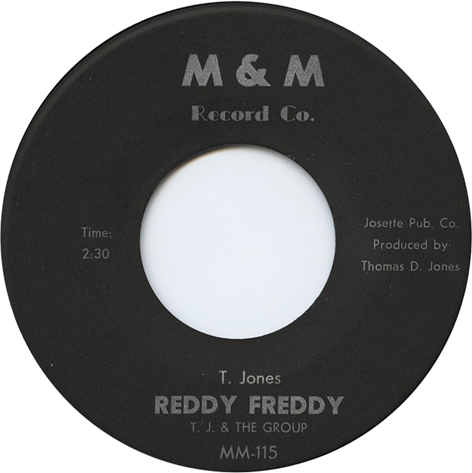
Another session from this period featured Artee "Duke" Payne, who played tenor saxophone and flute in Odell Brown's Organ-izers; drummer Curtis Prince was also a regular member of the group. The Organ-izers occasionally threw some avant-garde ingredients into their soul stew, and Payne's M&M outing was frankly experimental—psychedelic jazz highlighted by Payne's first outing on the bagpipes.
Artee "Duke" Payne (bagpipes -1; electric ts -2); (vib); (org); (eg); (eb); Curtis Prince (cga, perc).
Chicago, late 1960s
| 7759 | The Bottom (A. Payne) -1 | M&M 758 | |
| 7760 | Reaction (C. Prince) -2 | M&M 758 |
Even by the standards of the Mad complex of labels, the Duke Payne disc is exceedingly rare, and commands prices up to $200. The sonics are congested and one wonders where this 45 was recorded. The group performs psychedelic jazz-funk (including prominent wah-wah guitar) with an overlay of exotica. On "The Bottom," Duke Payne's bagpipes are featured; to our knowledge he was the second jazz artist, after Rufus Harley, to record on them. The pipes are replaced on "Reaction" by Payne's customary ax; it also appears to be electrified. The composer credit on "Reaction" points to Curtis Prince on percussion.
Our thanks to the Funky16Corners blog (http://funky16corners.com/?p=3859) for pointing out the Odell Brown connection. However, Brown does not appear to be the organist on this session. Payne made a second single featuring his bagpipes. "Listen Heah" (Bunky 7765) was credited to a studio band called Bros. in Co-Op Featuring Duke Payne, on a session produced by future soul star Donny Hathaway for a latter-day Sheppard label. According to Office Naps' entry on jazz bagpipes, http://officenaps.com/jazz-obscura/bagpipes/, the Bunky single, on which Payne's pipes benefit from cleaner recording, was made in 1968 or 1969. Artee Payne was still performing in 2005, and still featuring the bagpipes.
For what used to be session Mad41, see the listing for Tommy Jones' LP A Song for Mary (below at Mad44).
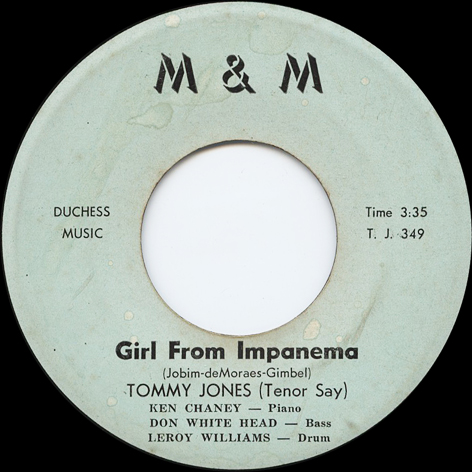
Tommy Jones (ts); Ken Chaney (p); Don Whitehead (b); Leroy Williams (d).
Chicago, 1960s
| T.J. 349 | Girl from Impanema [sic] (Jobim-deMoraes-Gimbel) | M∓M TJ 349 | |
| T.J. 350 | Autumn Leaves (Prévert-Cosma) | M&M TJ 350 |
Here is one of Tommy Jones' best straightahead jazz outings. The personnel is listed on the labels. Jones must have loved "Autumn Leaves," a standard that he recorded at least 3 times. The version on this single runs to 4:00 and Chaney's piano is prominent in the accompaniment. Jones will win no prizes for his ability to spell Portuguese words, but his rendition of "Girl from Ipanema" is also a winner. The recording quality is rough and ready; along with the shouts from the participants and the condition of the piano, it indicates that the sides were probably cut in an empty club.
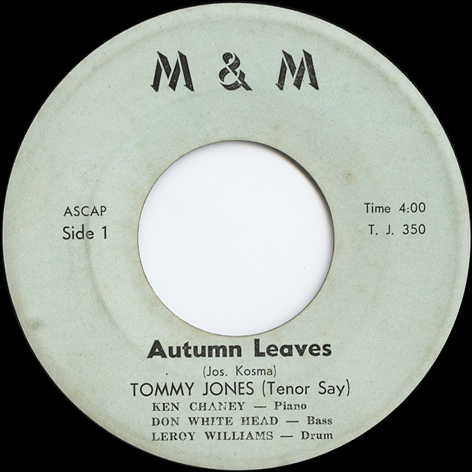
Tommy Jones (ts, voc); Bobby Pierce (org); Isaac Davis (d).
Chicago, early 1970s
| Autumn Leaves (Prévert-Cosma) | M&M SA-191, Mad A1 [CD] | ||
| A Song for Mary | M&M SA-191 | ||
| My Funny Valentine (Rodgers-Hart) [TJ voc] | M&M SA-191 |
This version of "Autumn Leaves" was reissued in 1991 on Tommy Jones' last production, a CD on Mad A1. Titled Tommy "Madman" Jones & His Friends: Chicago Style 1960-1976, it was issued in the Netherlands in 1991.

Tommy Jones (ts); John Logan (org); George Freeman (eg); James Wills (eb); Master Henry Gibson (cga); Curtis Prince (d).
Chicago, early 1970s
| 7762-A | Manha de Carnival [sic] (A. Maria and L. Bonfá) [Day of Carnaval*] | M&M 7762-A, M&M SA-191*, Mad A1 [CD] | |
| 7762-B | The Shadow of Your Smile (P. Webster-J. Mandel) | M&M 7762-B |
M&M 7762, a gold label 45 rpm single, was released at an unknown date. We'll assume it was the early 1970s, as with the other tracks that were used on Jones' LP A Song for Mary. "The Shadow of Your Smile" was not used on the LP, and to our knowledge it has not been reissued anywhere else.
We've heard reports of a different version of M&M 7762 with "Reddy Freddy" as the B side. Still to be investigated.
The track that appeared on A Song for Mary was reissued again in 1991 on Mad A1, a CD titled Tommy "Madman" Jones & His Friends: Chicago Style 1960-1976. There Jones made an effort to revert to the original Portuguese: "Mahna [sic] de Carnival [sic]."
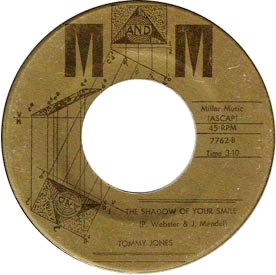
Tommy Jones (ts); Charles Morgan (p); Hawk Lee (b); William "Bugs" Cochran (d).
Chicago, early 1970s
| Desert Dream | M&M SA-191 | ||
| Chucks Blues | M&M SA-191 | ||
| Fools Rush In | M&M SA-191 | ||
| Satin Doll | M&M SA-191 |
M&M SA 191, called A Song for Mary, was probably recorded and released in the early 1970s, by which time WBEE had switched over to an all-jazz programming and Mary Dee was still working there. The LP is dedicated and named for the popular deejay. The liner notes also say that George Freeman was working with Gene Ammons, so the LP predates Jug's death in 1974. The material ranges from standard bebop to smooth jazz. Original compositions by Jones were "Desert Dream," "Chucks Blues", and "A Song for Mary."
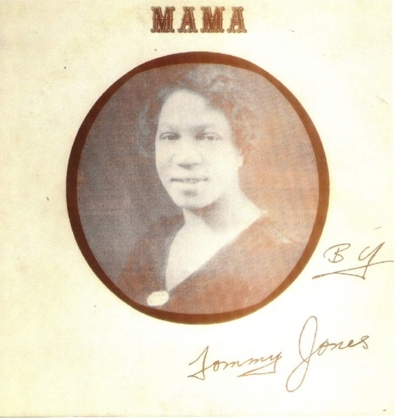
Odyssey Sound Studio, Chicago, c. 1974
Tommy Jones (ts, voc*); Allen Batts (org); Eugene Howell (eg); Nate Steward (b); Roy Robertson (d).
| Shirley (Jones) | M&M 2891-T.B. | ||
| Mama (Jones-Alexander) | M&M 2891-T.B. | ||
| Stormy Weather (Arlen-Koehler) * | M&M 2891-T.B. | ||
| TJ-1A | Eggnog (Jones-Alexander) | M&M 2891-T.B., M&M TJ1-A | |
| [alt.] | Egg Nog (Jones-Alexander) | unissued acetate C | |
| [alt.] | Laura (Raksin) | unissued acetate C | |
| At Last* (Warren-Gordon) | M&M 2891-T.B. | ||
| Blues For Gene (Jones) | M&M 2891-T.B. | ||
| Harlem Noctorne [sic] (Hagen) | M&M 2891-T.B. |
This LP was called Mama and was dedicated to Jones's mother, Lillian Jones, who had passed away. If the LP cover looks old, it's because her photo was taken in 1930. The inclusion of a "Blues for Gene" suggests that the recording session also took place after Gene Ammons' death. The album contains the usual combination of original compositions by Jones and standards and swings a little more but is less beboppish than A Song for Mary. Personnel as listed on the back liner and the labels. This LP is not listed in Lord.
The single that appears to be associated with this album ("Egg Nog" b/w "F. A.") is said in some sources to carry the release numbers 1A and 2A, but the matrix numbers are in fact TJ-1A and TJ-1B. (Our thanks to Dan Ferone for information about the single.) "Egg Nog" on the single comes in at 2:40, so if it is the album track it has been edited. On the single "Egg Nog" is attributed to Roy Alexander—while the album cut is jointly credited to Alexander and Jones—and the instrumental lineup is the same one that is credited on the LP. "F. A." is a reissue of the ballad recorded on Mad21 from 1961, for Jones' LP A Different Sound.
Another version of "Egg Nog," which sounds like an alternate take from this session, is on a 7-inch 45 rpm acetate now in the possesion of Armin B&umml;ttner. The other side of the acetate, unfortunately with more surface damage, is a version of "Laura" with the same rhythm section, running to 4:05.
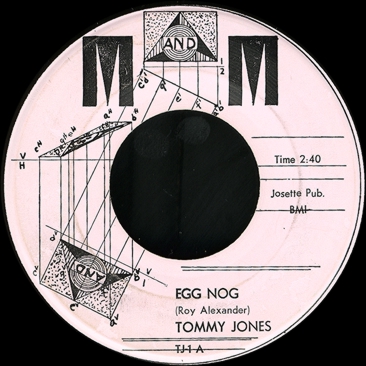
Jones, who sang in a rather cavernous bass-baritone, is said to have sped up some of the tracks on A Song for Mary to get a brighter sound and a hotter sounding performance. We detect some speed-up on "Stormy Weather," which features Jones' vocals—and has already been perked up with a samba rhythm. The other vocal number, "At Last," is less affected, if at all.

Tommy Jones (ts, voc, perc); Willie Jones (p); Larry Frazier (eg, voc); Bruce Hayden (vin -1); Eldee Young (b); Phil Thomas (cga, voc); William "Bugs" Cochran (d).
Chicago, prob. early 1970s
| Good Thang | M&M TD-5516 | ||
| 47123-1 | Sweet Lena (Frazier) | M&M 47123, M&M TD-5516 | |
| Dream Samba -1 | M&M TD-5516 | ||
| 47123-2 | Larry's Blues (Frazier) | M&M 47123 |
M&M TD5516 was an LP titled Bow Legs. This one is listed in Tom Lord's Jazz Discography. Lord gives the date as the 1980s, but that is the release date, not the recording date for the material. The LP cover gives a California P.O. box for M&M.
An M&M single (on 45 rpm, in stereo) from this session was discovered in March 2013. It carries "Sweet Lena" on one side and the previously unknown "Larry's Blues" on the other. We don't know the date of release, but the single was probably well in advance of the album.
The session was done professionally in a studio, in stereo. "Good Thang" is pure bebop and features Willie Jones extensively. "Larry's Blues" is a feature for Larry Frazier's guitar; it also allows Tommy Jones to show off his jazz-funk chops. The other two cuts on this session and the two on the following session are somewhat mellowed out barwalking material. Of the very rare appearance on record by Bruce Hayden, jazz violin scholar Anthony Barnett says, "although Hayden only plays obbligato violin on one track Dream Samba his breathy tone is quite beautiful and begins to explain why Leroy Jenkins has paid tribute to him as a teacher."
We previously listed a session with Willie Jones on piano as Mad48. However, there was just one track with two different titles (not the two tracks we listed) and it came from the session c. 1963 (Mad24a) that Tommy Jones originally released on his LP A Different Sound.
Tommy Jones (ts, voc); Earma Thompson (p); Fred Hopkins (b); Marshall Thompson (d).
Chicago, 1960s or early 1970s
| LP5-A 1200 | Hush Now, Don't Explain [Hush Now*] (Billie Holiday) | LP5-A, Mad A1 [CD]* | |
| LP5-B 1200 | Honky Tonk (Doggett) | LP5-B |
LP 5 is written in the wax and on the label of what is in fact a single. The 1200 is written in the wax only. "Honky Tonk" is the old Bill Doggett tune. In the liners to his 1991 CD issued in the Netherlands, Jones said simply "'Hush Now' was one song on a session that was never released." This could mean that the single release came after the CD release. However, one can hear surface noise on the track as released on Mad A1.... In fact, the tune is "Don't Explain" as retitled by Jones from memory (the single gives it as "Hush Now, Don't Explain"). Jones' liner notes provided the personnel as well.
George Freeman (eg); John Logan (org); Curtis Prince (d); others unidentified.
Chicago, ca. 1973-74
| 21670-A | The Monster (Freeman-Prince-Logan) | Honey 216A | |
| 21670-B | 1-2-3 | Honey 216B |
The composer credits on this psychedelic funk single point to Jones' house band during the 1970s, according to small label expert Jamie Hodge. Jones' company Josette is the publisher, and the Honey subsidiary may have been named after one-time Mad recording artist Honey Brown.
Sam Chatman (voc); musicians unidentified.
Chicago, mid-1970s
| HO-1472A-1D1472C | Daybreak (S. Chatman) | Honey HO1472A | |
| HO-1472B-1D1472C | I Know My Baby Loves Me (S. Chatman) | Honey HO1472B |
This is a blues-funk recording, and was undoubtedly an outside production. Sam Chatman, who can be seen in a 1959 photo with Lefty Bates above, had been on the Chicago scene for over 20 years by this time.
Tommy Jones (ts, voc); John Young (p); Milton Suggs (b); Robert Shy (d).
Chicago, probably mid 1970s
| Little John (R. Spotts) | Mad A1 [CD] | ||
| Autumn Leaves (Prévert-Cosma) [TJ voc] | Mad A1 [CD] | ||
| Theme for Ernie | Mad A1 [CD] | ||
| Morning Mist (R. Spotts) | Mad A1 [CD] | ||
| High Fi (Jones) [TJ voc] | Mad A1 [CD] | ||
| Laura (Raksin) | Mad A1 [CD] |
Tommy "Madman" Jones & His Friends: Chicago Style 1960-1976 was a CD released in the Netherlands in 1991. Around half of the material on the CD was previously released on Mad or M&M, but this session seems to have been included for the first time. Jones provided the personnel in his notes; of the session he said, "The first six numbers were cut in one session and, because I did not have more money, the session lasted three hours, plus one hour for rehearsal." The session was definitely cut with LP release in mind, because the shortest of the six pieces times in at 5:15, and three of the six would have fit nicely on each side. "High Fi," a blues that Jones sings on, is the same number (but, of course, not the same performance) as "Hi Fi Apartment" from session Mad1.
Tommy Jones (ts); Tom Gastineau (ep; synth-1); Juewett Bostick (eg); Phil Upchurch (eb); Moises Obligacion Jr. (cga, bell); J. "Rini" Kramer (perc); Frank Wilson (d, timbales).
Los Angeles, early 1980s
| Blue Jay | M&M TD-5516 | ||
| Bow Legs (T. Jones) | M&M TD-5516, Mad A1 [CD] | ||
| Shirley | M&M TD-5516 | ||
| Motherless Child -1 | M&M TD-5516 |
The material here was probably recorded in the early 1980s, and was definitely recorded in Los Angeles. The music is jazz-rock and highly pop oriented. At least on "Bow Legs" Gastineau plays an electric piano.
Mad A1, Tommy "Madman" Jones & His Friends: Chicago Style 1960-1976, was a CD that Jones issued in the Netherlands in 1991. This session, of course, was not made in Chicago and surely postdates 1976.
In the mid-1980s Jones moved to the Netherlands and developed a career in Europe. He rarely used the "Madman" moniker at this point. Herbert Noord, an organist who has been active on the Dutch scene since 1964, recalled his years with Tommy Jones in an email (May 4, 2002):
The first time I met Tommy was on a Sunday afternoon in 1986. I was organizing a jazzclub in Amsterdam (Holland) at that time. The owner of a discotheque with nothing to do at the Sunday afternoon gave me the opportunity to organize something that might attract customers.
With the help of a local radio station and some friends we succeeded in getting the club off the floor and every Sunday the number of listeners was growing (also due to the fact that the admission was very low: $1). On a Sunday the owner introduced us to Tommy, who lived temporarily in one of his apartments.
Tommy was very pleased that he could play with me, because he liked to play with the Hammond organ. Tommy wasn't the greatest tenor-player or singer but he had something very personal in his playing and singing and he had definitively the blues. By the way his voice was sounding remarkably young even when he was far in his sixties. Another remarkable thing was his circular breathing technique when he played the tenor.
We played in clubs in- and outside Amsterdam and did a special one month tour through the country with another coryphaeus of American Jazz History, guitar-player Paul Weeden Sr.
This tour was so successful that we did another the following year. After that tour we went into the recording studio of Max Bolleman, the famous recording engineer, and recorded in February 1989 the album Hi-Fi Apartment. On this album are three Tommy Jones originals: "Hi-Fi Apartment," "I Am a Lushhead (sic)" and "Whave the Blues." All sung by Tommy.
The album was released by Charly/Affinity in 1989 as CD Charly 196 and rather successful.
After the release of the album we did a promotional tour. After that tour Tommy started in Amsterdam a barbeque restaurant. Partly because he was sick of all the traveling, partly because he wanted to make money. He didn't really succeed in this effort. The restaurant was closed after a year. Tommy phoned me after the closure of his culinary adventure and asked if I would do a recording session with him. I asked me to organize the session and I invited a nice American guitar player John Butler and a well-known Dutch drummer Bram Wijland.
We went to the studio of Max Bolleman to record six songs. It wasn't a bad session but the problem was that Tommy wanted to play and sing at the same time. He didn't want to dub in the singing or the saxophone playing afterwards.
This was partly because Tommy was running out of money. At the end he didn't have enough money for the mix and the whole project [was] stranded. Lucky enough we made a spare tape so the session is saved. It gives a good impression of Tommy's music.
Tommy was besides a musician, a composer and a cook also a painter. In a way he was a very complete artist. It was a pleasure for me to have known him and to work with him. Due to all causes I lost contact with him just a couple of months before he left Amsterdam. He had already handed me the compilation CD of his Chicagoan years. Most remarkable song: "The Snake Charmer" [see Mad3 above].
Tommy Jones was still residing in Amsterdam when he put out this last production, Mad CD A1. The first six tracks were previously unreleased but all of the material had been recorded before his sojourn in Europe, and all but one track in Chicago; see various sessions above for the listing. Of Jones' final years in Amsterdam, bassist Arjen Gorter (email of August 13, 2001) recalls:
When I first saw Tommy Jones at the only real jamming spot in Amsterdam, I realized that I had passed him on the streets before, while he was busking in front of the Amsterdam Central [Railroad] Station. That time his playing had been mostly wiped out by the traffic noise around him, and at the sessions it was clear that his health was not the greatest. But he enthusiastically participated in the goings-on and I'm sure local tenor players Sean Bergin and Toby Delius ... have a few stories about those days. On one of these occasions he offered the CD for sale...

In 1992, Tommy Jones returned to the United States, presumably to die. By May 1993, when Robert Pruter interviewed him, he was suffering from a severe lung ailment and had to go to his oxygen mask every two or three questions. Jones sadly said, "You are the second person to show some interest in my work. And what is it, thirty or so years later. I had just given up completely." (Chicago blues deejay Steve Cushing had interviewed him over the phone a few months earlier and featured some of his recordings on a show.) Tommy Jones died on October 25, 1993. He had turned 71 just six days earlier.
Our principal sources on Mad and Tommy Jones are "R&B Ramblings," Cash Box, 28 December 1957, p. 54; "'Mad Man' Jones Sets Own Disc Outlet; Hits," Chicago Defender, 31 May 1958; [Obit] Down Beat, February, 1994, p. 14; various Chicago Defender clips from 1945 to 1960; and the Tommy Jones telephone interview with Robert Pruter, 25 May 1993. Indispensable for this page was our interview with Dr. Robert Stallworth who supplied us with discographical information from his collection as well as plentiful scans of the varied Mad and M&M label designs. We are further indebted to Dan Ferone for turning up additional M&M releases such as the previously unreported two versions of M&M 25, and to Dick Shurman and John Corbett for turning up the previously unknown Tommy Jones LP A Different Sound (M&M LM-27). A Different Sound is, in our opinion, the greatest of Jones' five LPs. Dan Kochakian turned up two references to Tommy Jones in Billboard, corrected our personnel listing for the Louis Carpenter single, and provided us with many Chicago Defender clippings. We are grateful to Arjen Gorter and Herbert Noord for their recollections of Tommy Jones from his years in the Netherlands. The search from Mad/M&M releases is still ongoing—so is the search for unreleased material by Tommy Jones. Collectors, please let us know what you find.